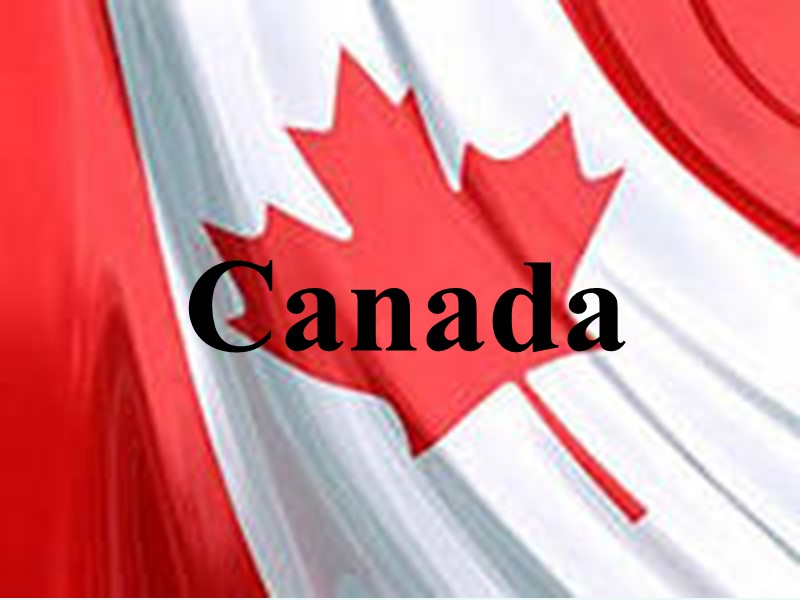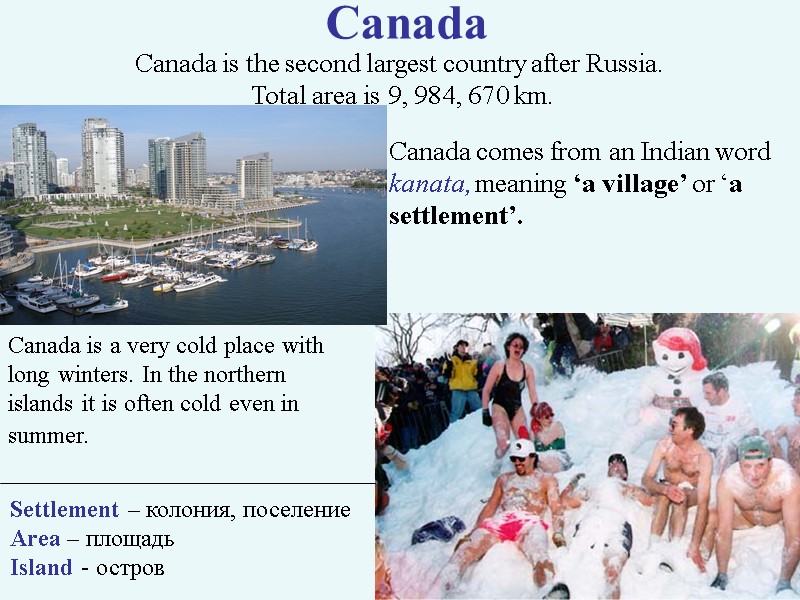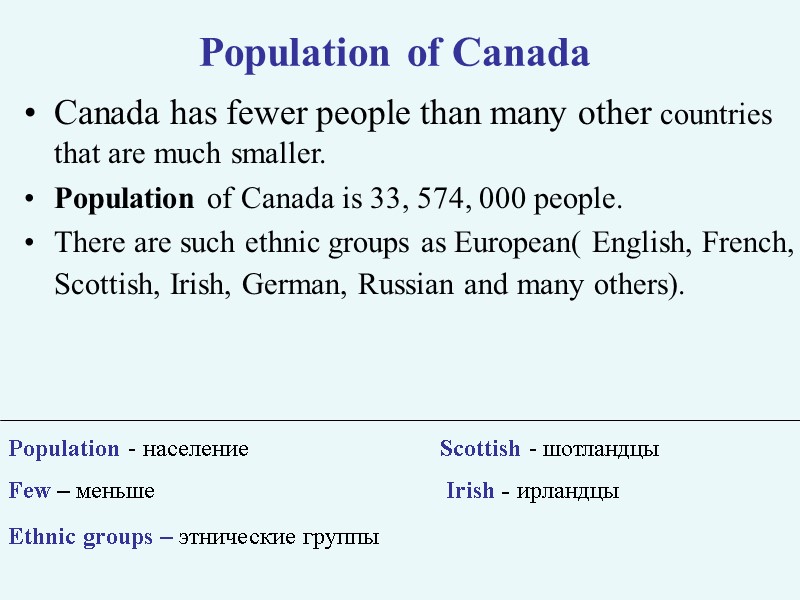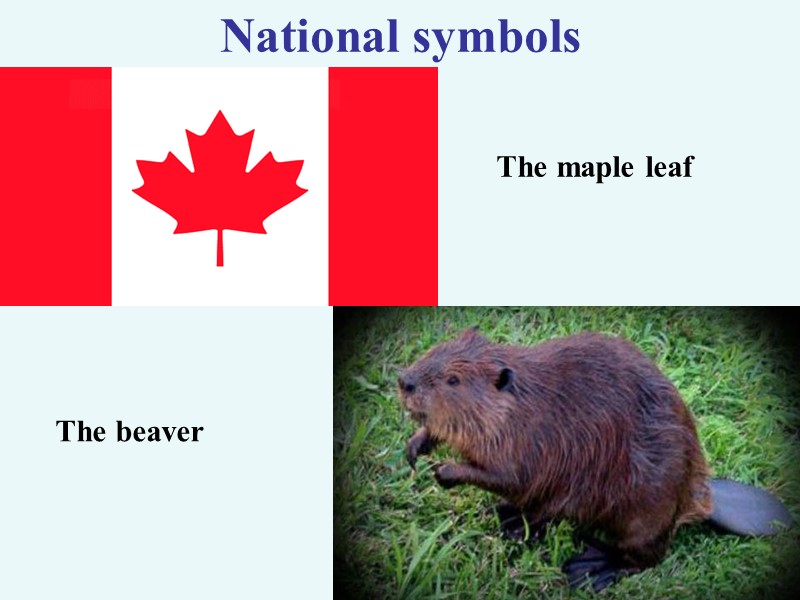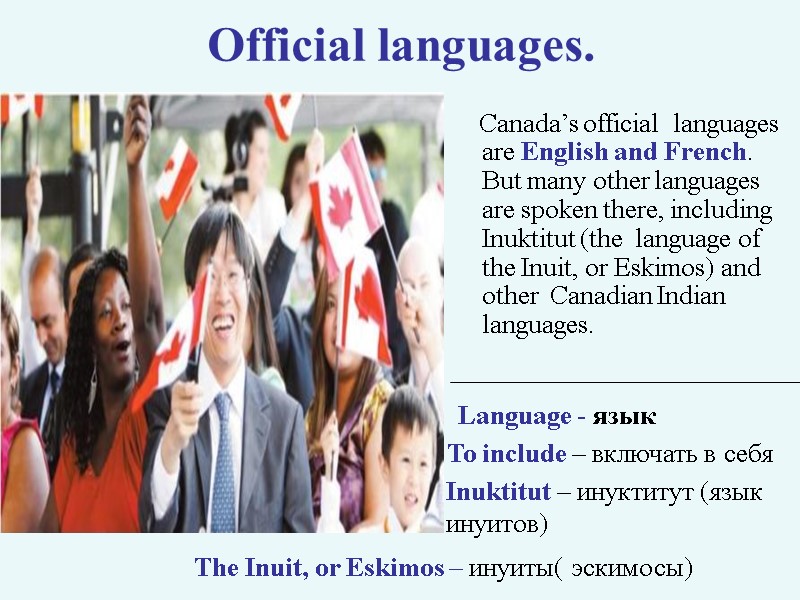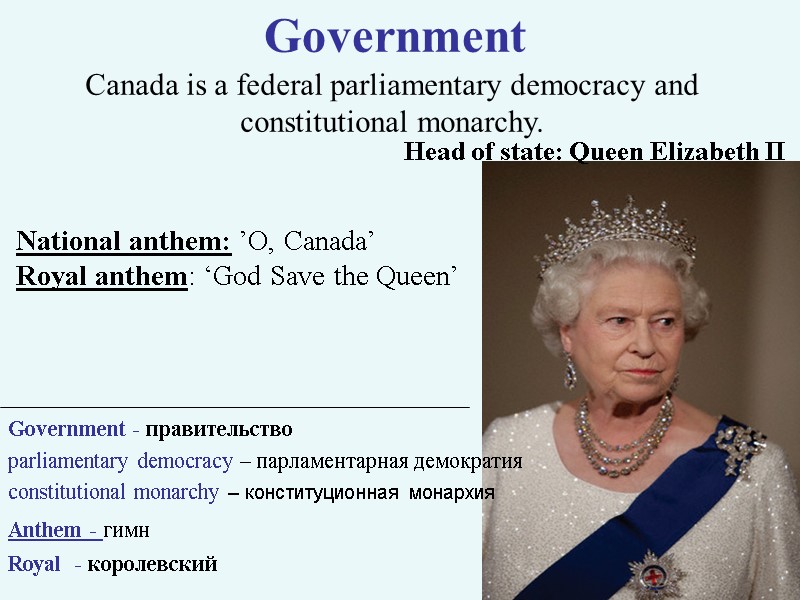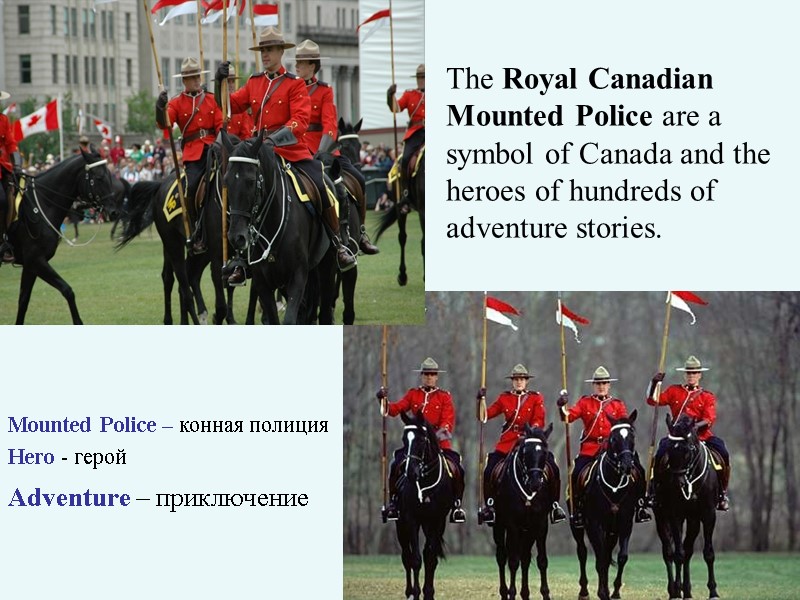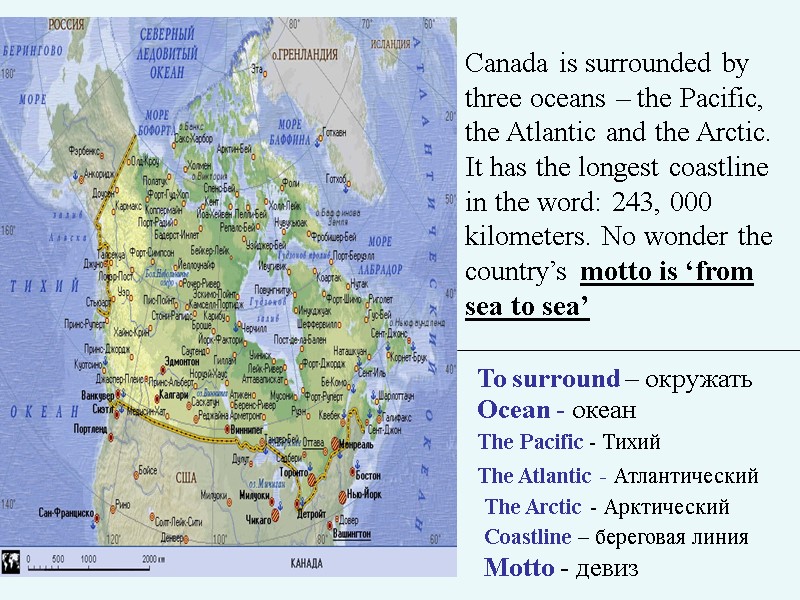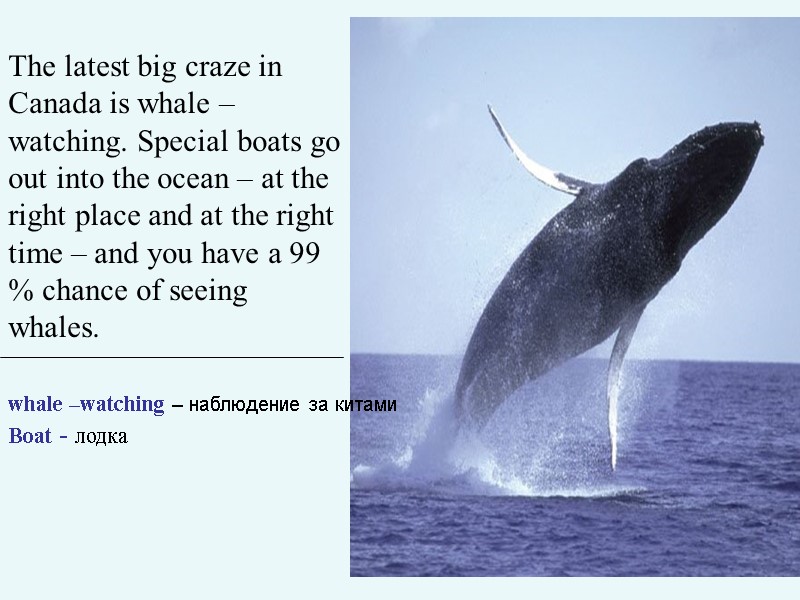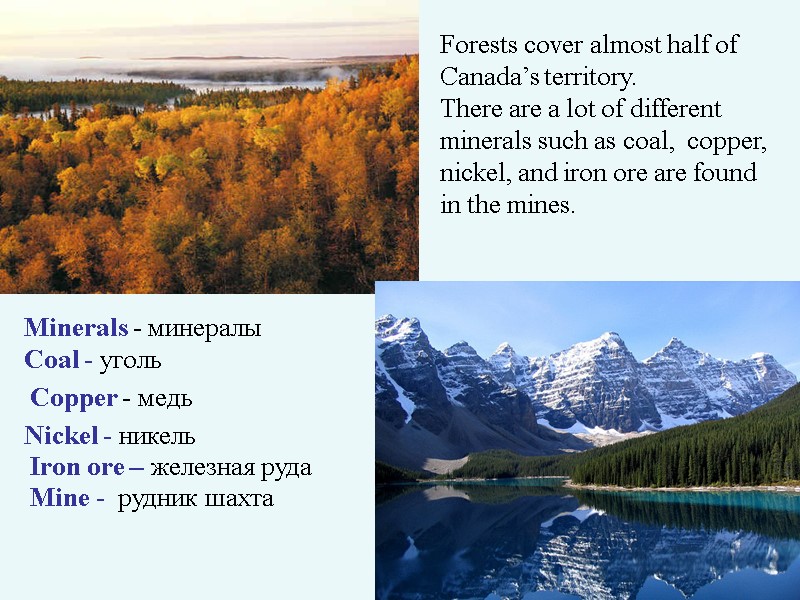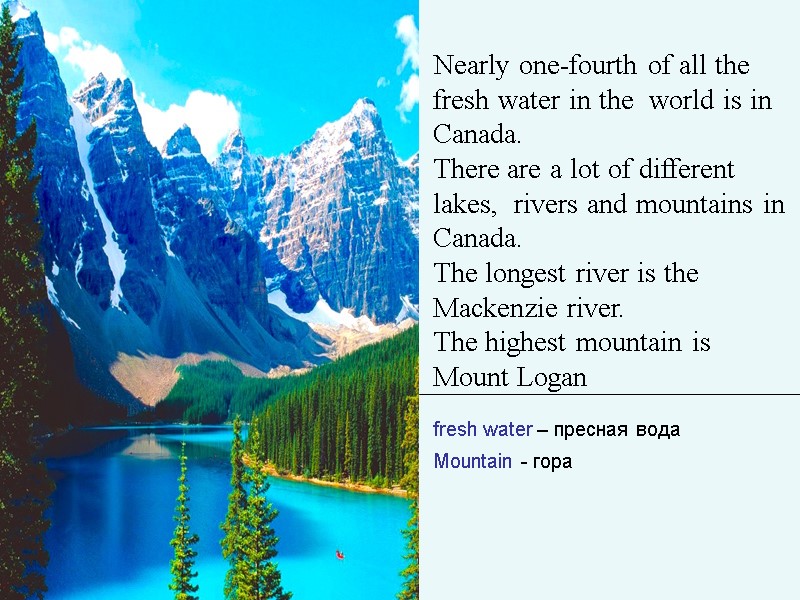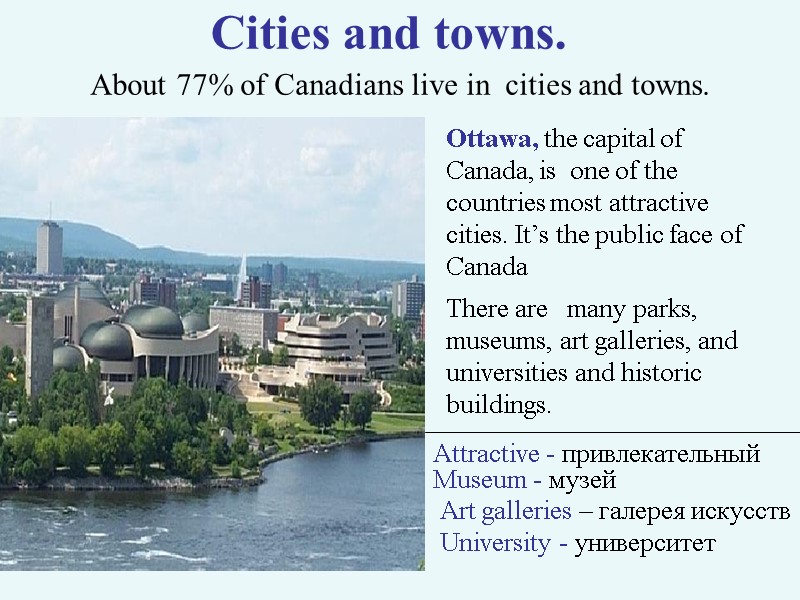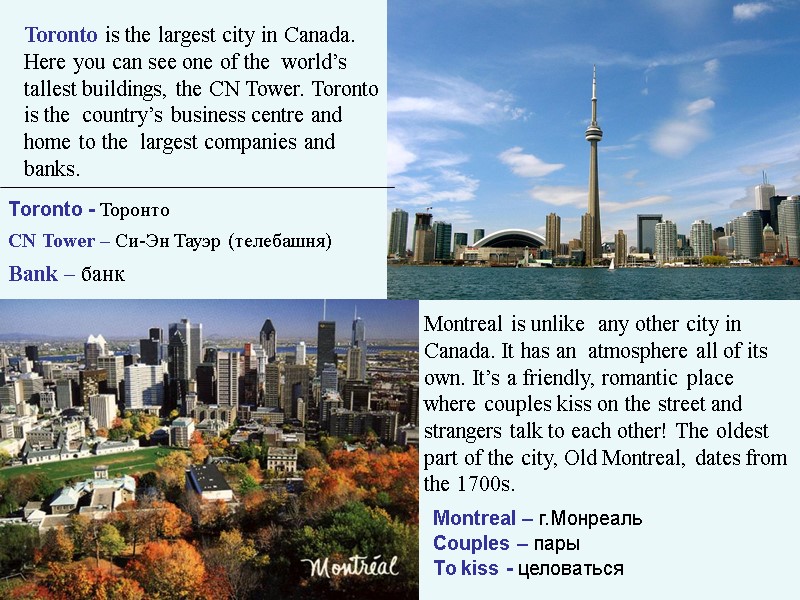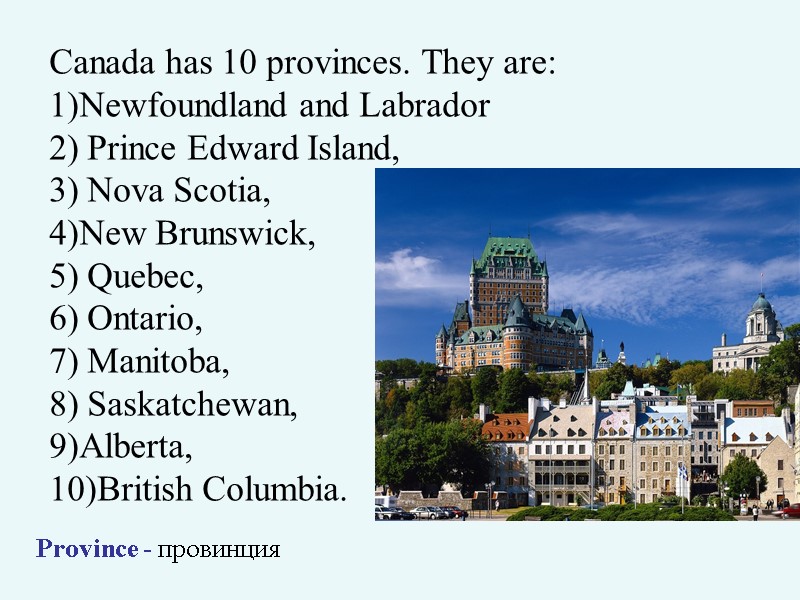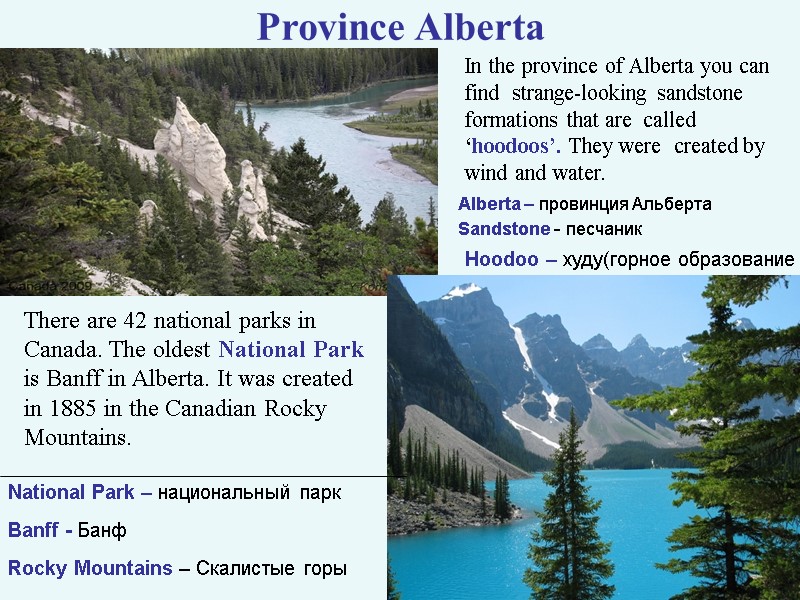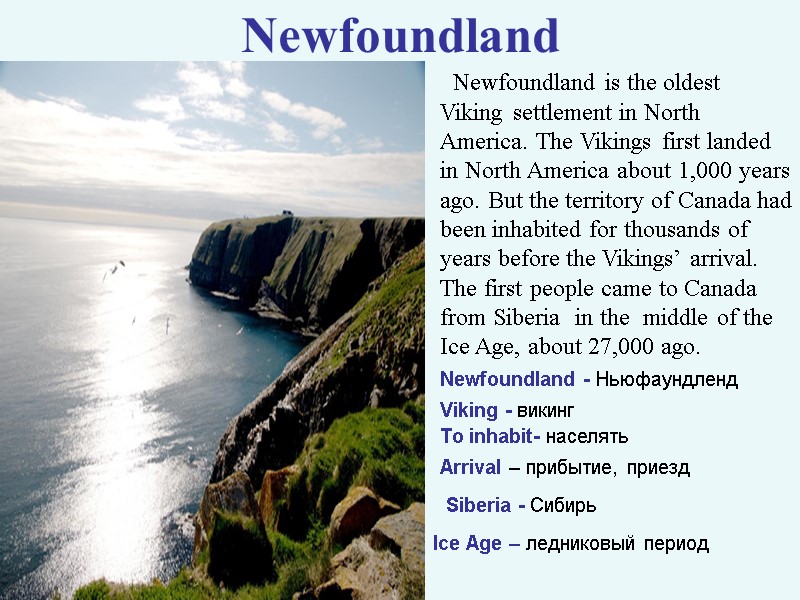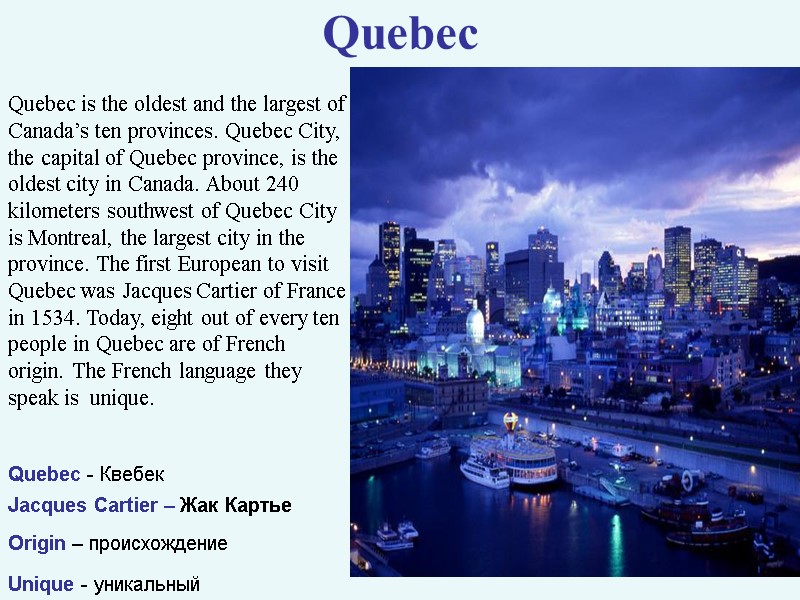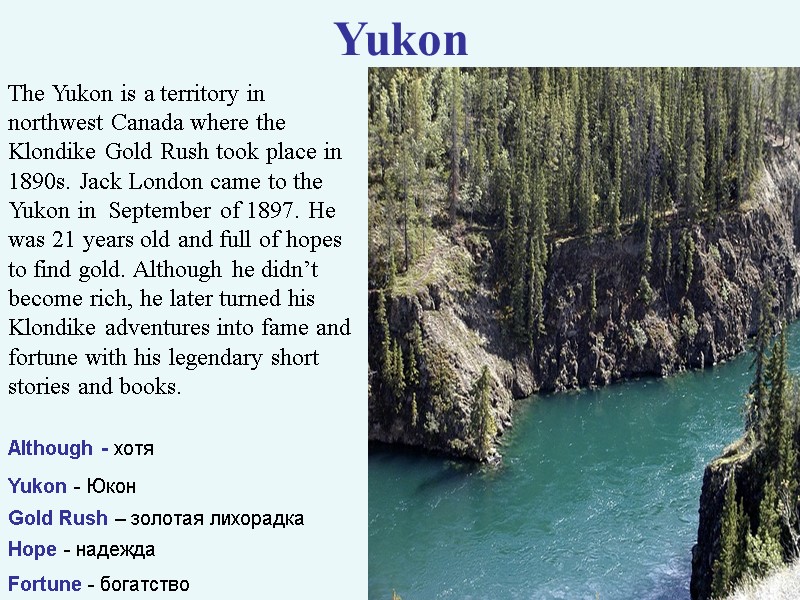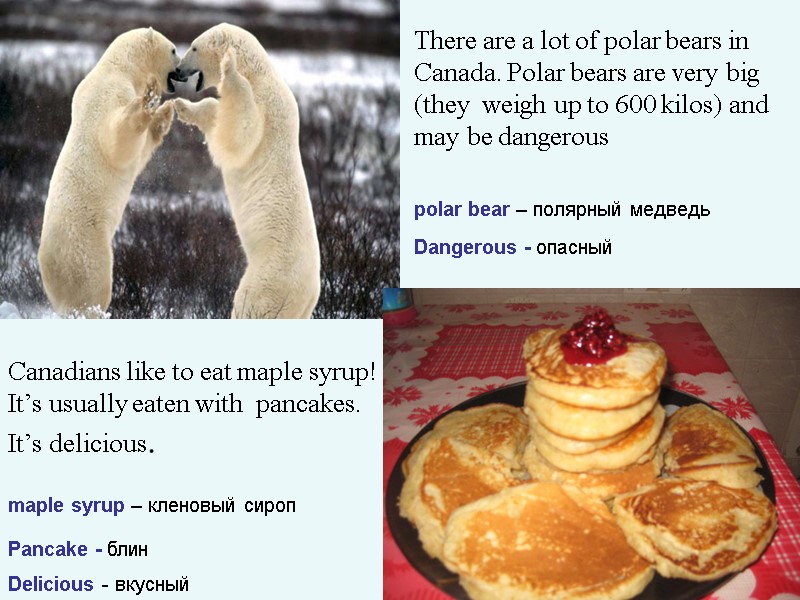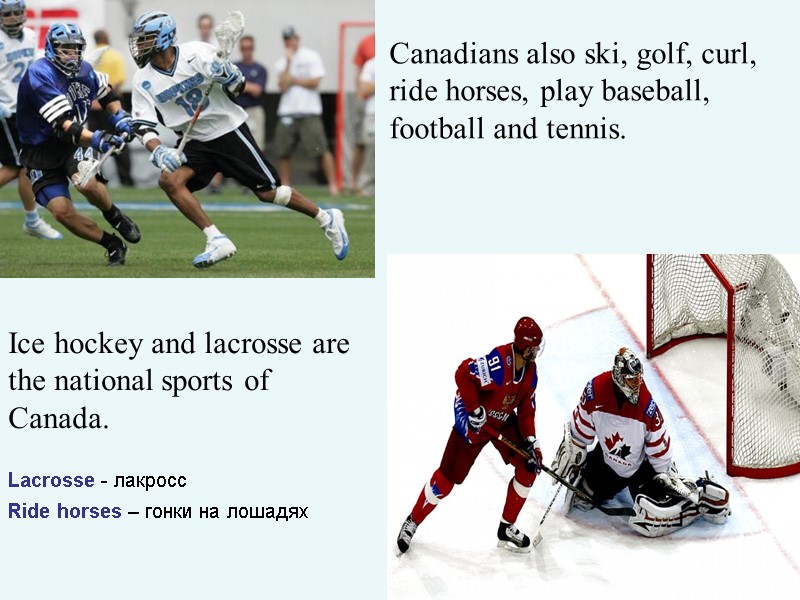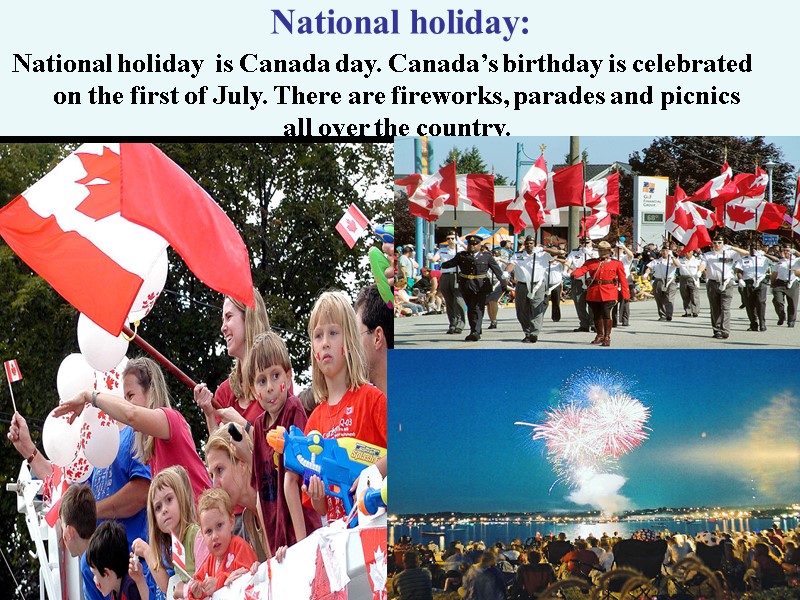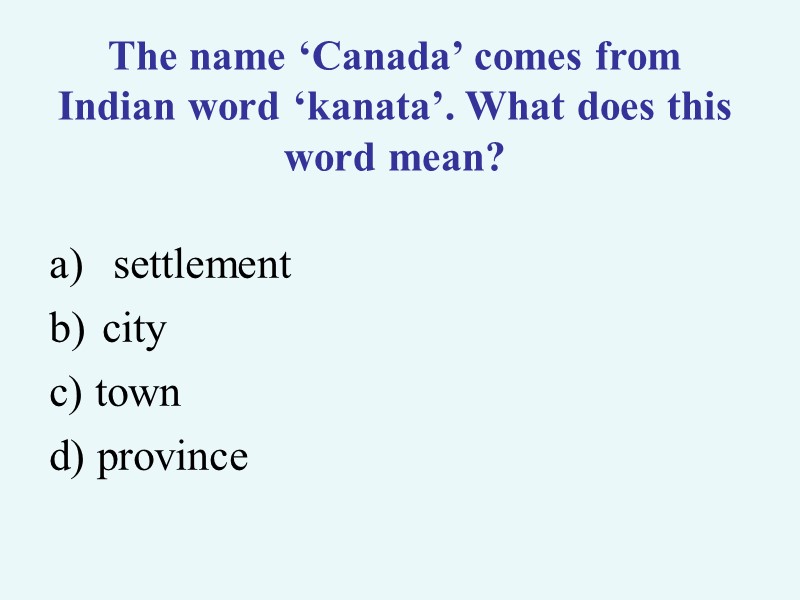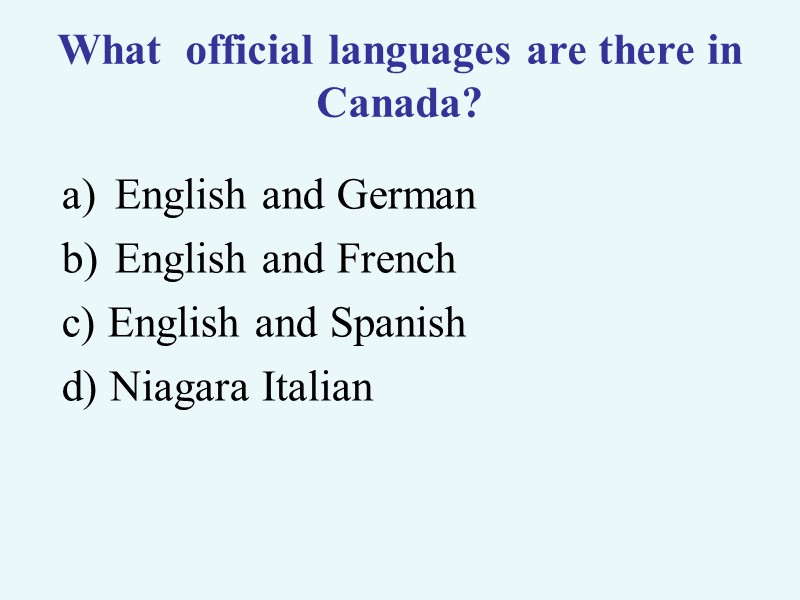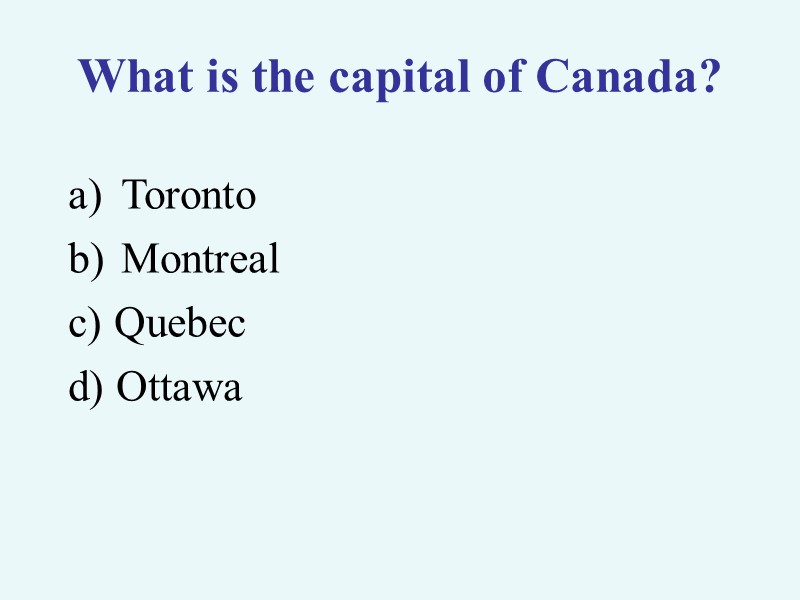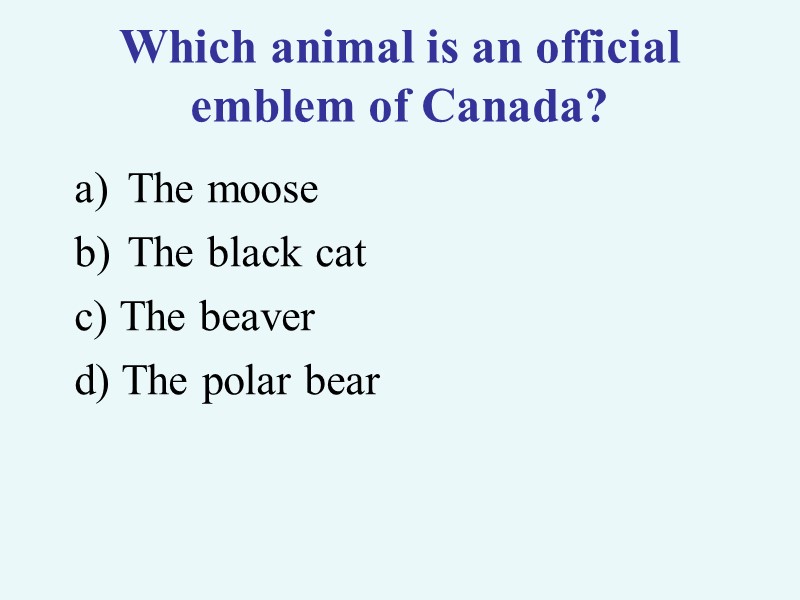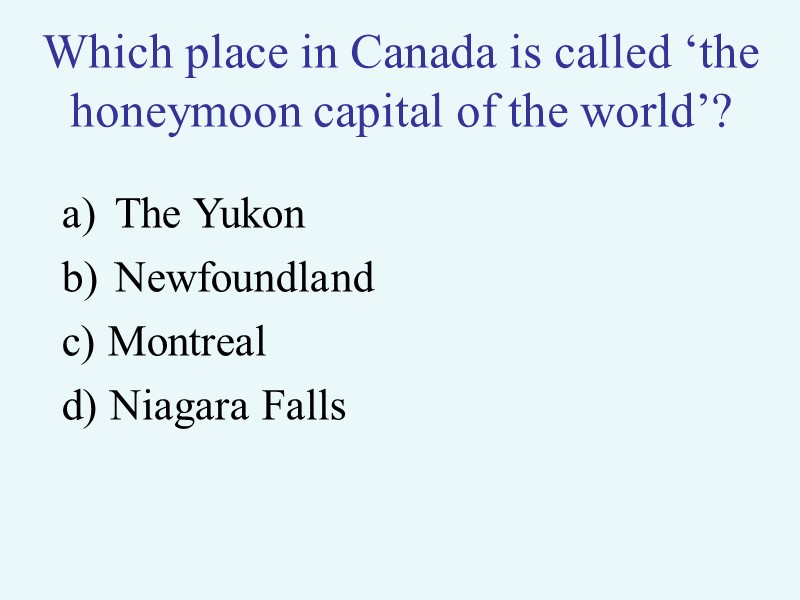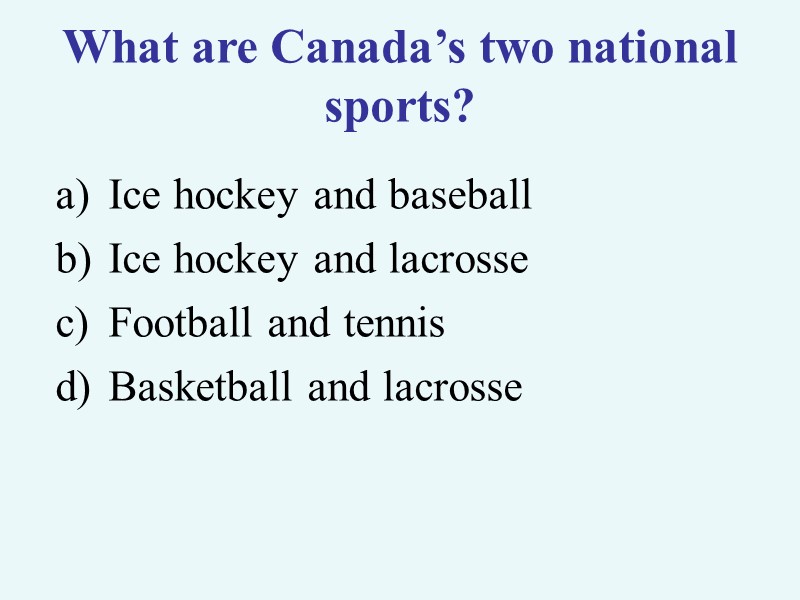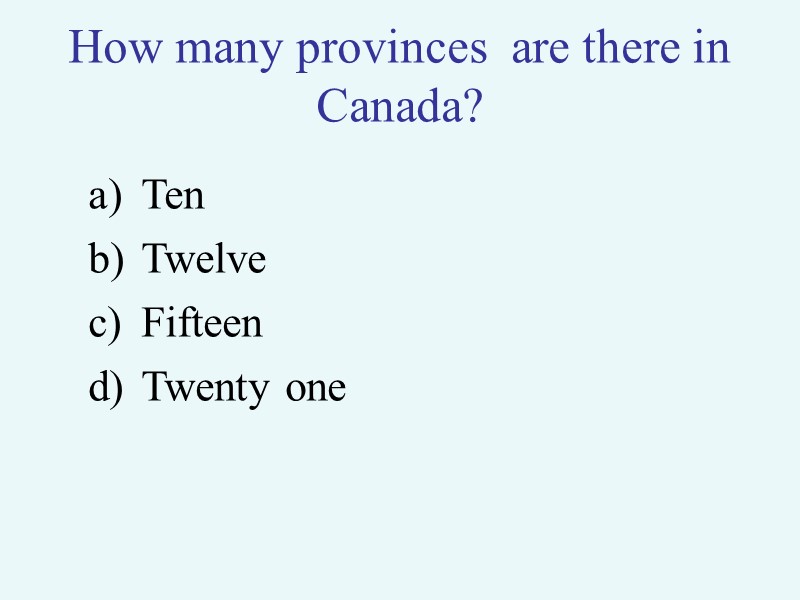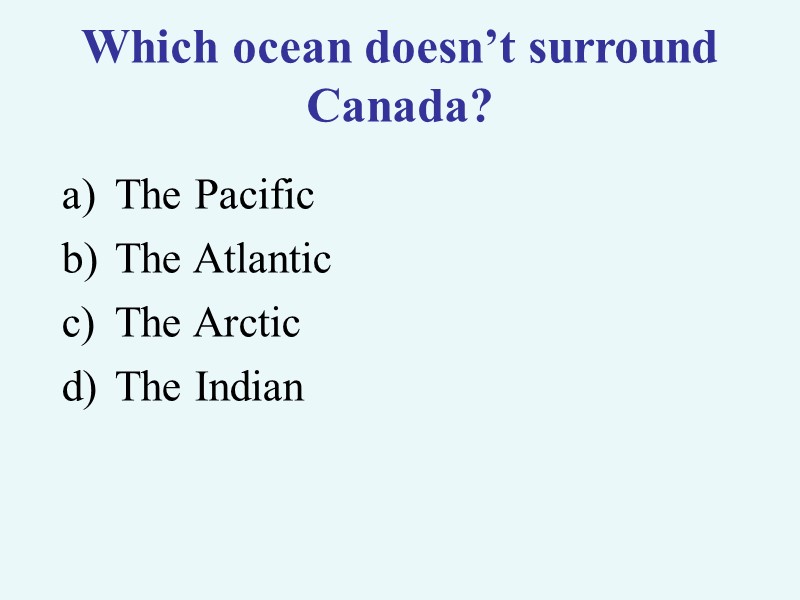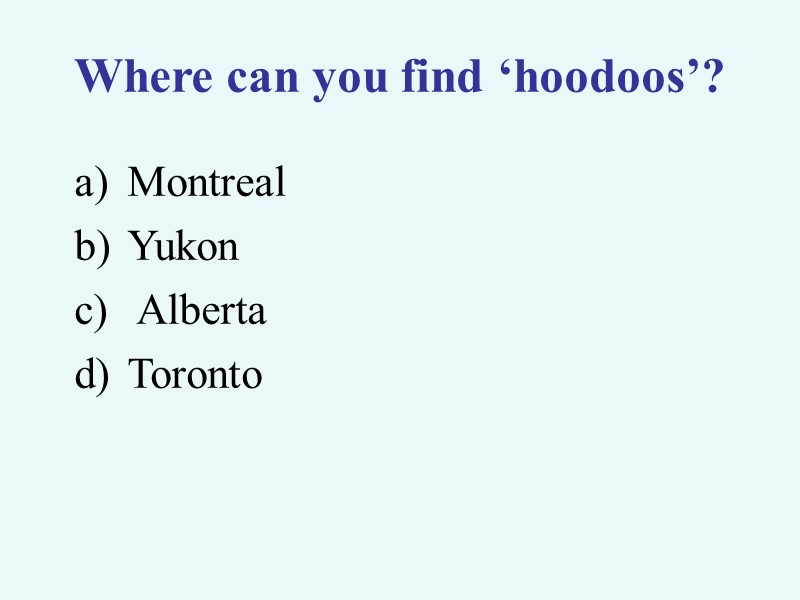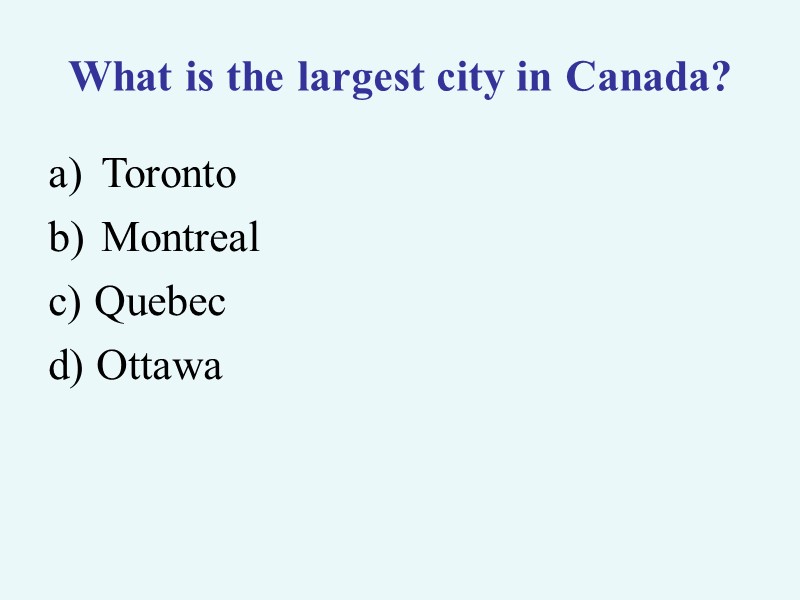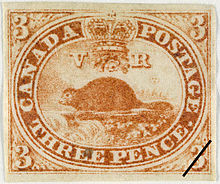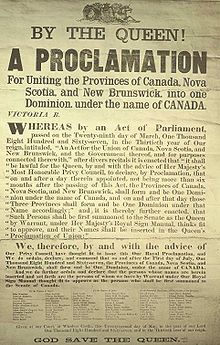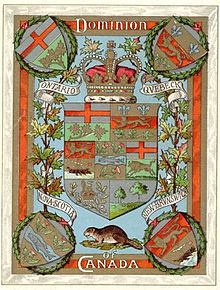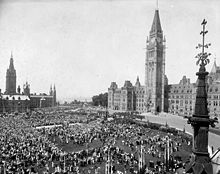- Текст
- Веб-страница
The name Canada is believed to come from the Indian word Kanata, meaning «village» or «community».This fact alone shows that the native population of the country consisted mostly of Indian tribes. Now Canada is the world’s second largest country after Russia and the largest country in the Western Hemisphere. The country is so wide that six distinct time zones lie within its borders. The capital of the country is Ottawa. Its currency is the Canadian dollar. The country’s most important symbol is the maple leaf.
The populated southern areas of Canada have a moderate climate when in the north the climate is characterized by very long, cold winters with average temperatures far below freezing and cool summer months. The most humid areas are in the west, where winds from the Pacific Ocean bring a lot of rain.
Canada has a population of over 30 million, about 80% of which live in the south. Canada’s largest metropolitan areas are Toronto, Montreal, Vancouver and Ottawa. The French were the first to settle in the country in large numbers during the 17th and early 18th centuries. People of British origin came to stay there mainly after 1763. As a result both French and English are official languages.
Canada has 10 provinces and 3 territories, each with its own capital city. French Canadians are mostly concentrated in the provinces of Quebec and New Brunswick. They have kept not only their language, but also their own culture. Both Ottawa, the country’s capital, and the largest city of Canada Toronto are situated in the province of Ontario.
The country is rich in natural resources: gas, oil, coal, gold, copper, iron ore, nickel, uranium, zinc, along with wood and water. It is one of the world’s leaders in mineral export and agricultural products. Forests cover about half of Canada. Forests also give home to deer and caribou, squirrels, minks, skunks, mooses, beavers, black bears and other animals.
Canada is a constitutional monarchy. Elizabeth II, Queen of England, is also Canada’s Queen and sovereign of a number of realms. The Queen is the head of state, and is represented in Canada by the governor-general.
Legislative power is vested in Parliament, which includes the Queen, the Senate of 104 appointed members and the House of Commons with about 300 elected members. National elections are held at least once every 5 years. The leader of the political party with the largest number of seats in the House of Commons usually becomes prime minister and forms the government.
There are three main political parties: the Liberal Party, the Progressive Conservative Party, and the New Democratic Party.
Each of the provinces and territories administers its own educational system. Schools are operated by local education authorities and generally give 6 to 8 years of elementary and 3 to 5 years of secondary schooling. Among the largest universities are the University of Toronto (Toronto), University of British Columbia (Vancouver), University of Alberta (Edmonton), in which the language is English. Famous French language universities are the University de Montreal and the University du Quebec.
0/5000
Результаты (русский) 1: [копия]
Скопировано!
Считается, что название Канада от индийского слова Kanata, означает «деревня» или «сообщество».Уже один этот факт показывает, что коренное население страны состояла преимущественно из индейских племен. В настоящее время Канада является второй по величине страной в мире после России и крупнейшей страной в Западном полушарии. Страна настолько широк, что шесть различных часовых поясах лежат в пределах своих границ. Столица страны – Оттава. Ее Валюта-канадский доллар. Наиболее важным символом страны является кленовый лист. Густонаселенных южных районах Канады имеют умеренный климат, когда на севере климат характеризуется очень долгой, холодной зимой со средней температурой намного ниже замораживания и прохладный летом. Самые влажные районы находятся на западе, где ветры с Тихого океана приносят много дождей.Канада имеет население свыше 30 миллионов человек, около 80% из которых живут на юге. Крупнейших городах Канады-Торонто, Монреаль, Ванкувер и Оттава. Французы первыми селиться в стране в большом количестве в течение XVII и начале XVIII веков. К там остаться главным образом после 1763 пришли люди британского происхождения. В результате французский и английский языки являются официальными языками. Канада имеет 10 провинций и 3 территории, каждая с собственной столицы. Франко-канадцев в основном сосредоточены в провинции Квебек и Нью-Брансуик. Они сохранили не только их язык, но и свою собственную культуру. Оттава, столица страны и крупнейший город Канады Торонто расположены в провинции Онтарио. Страна богата природными ресурсами: газ, нефть, уголь, золото, медь, железная руда, никель, уран, цинк, а также дерева и воды. Это один из мировых лидеров в экспорте минеральных и сельскохозяйственной продукции. Леса занимают около половины из Канады. Леса также дают домой оленей и карибу, белки, норки, скунсы, лоси, бобры, черных медведей и других животных. Канада является конституционной монархией. Елизавета II, королева Англии, также является королевой Канады и суверенным целого ряда сфер. Королева является главой государства и представлена в Канаде генерал-губернатором. Законодательная власть принадлежит парламенту, который включает в себя королева, 104 назначенных членов Сената и палаты общин с около 300 избранных членов. Национальные выборы проводятся по крайней мере один раз каждые 5 лет. Лидер политической партии с наибольшим числом мест в палате общин обычно становится премьер-министра и формирует правительство.Существует три основные политические партии: либеральная партия, Прогрессивно-консервативная партия и Новая демократическая партия. Каждая из провинций и территорий осуществляет свою собственную систему образования. Школы находятся в ведении местных органов образования и обычно дают 6-8 лет элементарных и 3-5 лет обучения в средней школе. Среди крупнейших университетов – в университете Торонто (Торонто), Университет Британской Колумбии (Ванкувер), университет Альберта (Эдмонтон), в которой языком является английский. Известный французский язык университеты находятся в Монреале университета и университета Квебека.
переводится, пожалуйста, подождите..
Результаты (русский) 2:[копия]
Скопировано!
Название Канада, как полагают, происходят из индейского слова Каната, что означает «деревня» или «сообщество» в одиночку .Этот факт говорит о том, что коренное население страны состояла в основном из индейских племен. Канада является второй по величине страной в мире, после России и крупнейшей страны в Западном полушарии. Страна настолько широк, что шесть различных часовых поясов лежат в пределах своих границ. Столица страны Оттава. Его валюта Канадский доллар. Наиболее важным символом страны является кленовый лист.
Населенные южных районах Канады имеют умеренный климат, когда на севере климат характеризуется очень длинными, холодными зимами со средними температурами значительно ниже замораживания и прохладно летом. Наиболее влажные районы на западе, где ветры с Тихого океана приносят много дождей.
Канада имеет население свыше 30 миллионов человек, примерно 80% из которых живут на юге страны. Крупнейшие городские агломерации Канады в Торонто, Монреаль, Ванкувер и Оттава. Французы первыми, чтобы обосноваться в стране в больших количествах в течение 17 и начале 18 веков. Люди британского происхождения пришли, чтобы остаться там в основном после 1763 г. В результате французский и английский языки являются официальными языками.
Канада имеет 10 провинций и 3 территорий, каждая со своей собственной столице. Франко-канадцы в основном сосредоточены в провинциях Квебек и Нью Брансуик. Они сохранили не только свой язык, но и свою собственную культуру. . И Оттава, столица страны, и по величине город Канады Торонто расположены в провинции Онтарио
страна богата природными ресурсами: газ, нефть, уголь, золото, медь, железная руда, никель, уран, цинк, а также с дерева и воды. Это один из мировых лидеров в минеральном экспорта и сельскохозяйственной продукции. Леса занимают около половины Канады. Леса также дают дома, чтобы олени и карибу, белки, норки, скунсы, лоси, бобры, черные медведи и другие животные.
Канада является конституционной монархией. Елизавета II, королева Англии, также Королева и суверенное ряда сфер Канады. Королева является главой государства, и представлена в Канаде генерал-губернатора.
Законодательная власть принадлежит парламенту, который включает в себя королеву, Сенат 104 назначенных членов и Палаты общин с около 300 избранных членов. Национальные выборы проводятся не реже одного раза в 5 лет. Лидер политической партии с наибольшим количеством мест в Палате общин, как правило, становится премьер-министра и формирует правительство.
Есть три основные политические партии:. Либеральная партия, Консервативная партия Progressive, и Новая демократическая партия
Каждый из провинции и территории руководит собственный образовательную систему. Школы находятся в ведении местных органов образования и в целом дать от 6 до 8 лет начальной и от 3 до 5 лет среднего образования. Среди крупнейших университетов в Университет Торонто (Торонто), Университет Британской Колумбии (Ванкувер), Университет Альберты (Эдмонтон), в котором используется английский язык. Известные университеты французские языковые университет Монреаля и Университета Квебека.
переводится, пожалуйста, подождите..
Результаты (русский) 3:[копия]
Скопировано!
Имя Канада считает из индийского слово тропарем, что означает «деревня» или «сообщества» .уже только один этот факт свидетельствует о том, что коренное население страны состояла главным образом из индейских племен. В настоящее время является вторым в мире после России и является крупнейшей страной в Западном полушарии. В стране настолько широкой, что шесть различных часовых поясов в пределах его границ.В столице страны, Оттава. Ее валюта — канадский доллар. Наиболее важными в стране символ — кленовый лист.
в густонаселенных районах Канады, в условиях умеренного климата при на севере климат характеризуется очень долго, холодной зимой со средними температурами до сих пор ниже точки замерзания и охлаждения летом. Наиболее влажных районах на западе,Где ветры от Тихого океана в дождь.
Канада имеет свыше 30 млн. человек, 80% из которых живут в южной. Канады в крупных городских районах, Торонто, Монреале, Ванкувере и Оттаве. В по-французски в первую очередь для урегулирования в этой стране в 17-е и в начале 18-го века. Людей британского происхождения появлялись в основном после 1763 года.В результате как на французском, так и на английском языке официальных языков.
Канада 10 провинций и 3 территорий, в каждом из которых есть свой город. По-французски канадцы главным образом в провинциях Квебек и Нью-Брансуик. Они сохраняют не только их языка, но также и их собственной культуры. Как Оттава, столице страны,И самый крупный город Канада Торонто расположены в провинции Онтарио.
страна располагает богатыми природными ресурсами: газ, нефть, уголь, золото, медь, железной руды, никеля, урана, цинка, а также древесины и воды. Она является одним из мировых лидеров в области разработки полезных ископаемых экспорт и сельскохозяйственной продукции. Леса покрывают примерно половина из Канады. Леса также дать дом для оленей и Caribou, белочка, зампрокурора, развившегося,Mooses, малый подорлик, медведи и других животных.
Канада является конституционной монархией. Елизавета II, Королева Англии, также Канада, кровать «куин-сайз» и суверенного ряда областей. Королева является главой государства, и они представлены в Канаде генерал-губернатора.
законодательная власть принадлежит парламенту, который включает кровать куин-сайз,Сенат 104 назначил членов совета и Палаты общин с около 300 избранных членов Совета. Национальные выборы проводятся не реже одного раза в 5 лет. Лидер политической партии, с наибольшее число мест в палате общин обычно становится премьер-министра и правительства.
существует три основных политических партий: Либеральная партия, прогрессивная консервативная партия,И новая демократическая партия.
каждой из провинций и территорий управляет своей собственной системы образования. Школы находятся в ведении местных органов образования и обычно от 6 до 8 лет начальной школы и 3 — 5 лет в средней школе. Среди крупнейших университетов, Университет Торонто (Торонто), Университет Британской Колумбии (Ванкувер), Университет Альберты (Торонто),В которой языком является английский. Знаменитый французский язык университетов — университете Монреаля и Университета du Quebec.
переводится, пожалуйста, подождите..
Другие языки
- English
- Français
- Deutsch
- 中文(简体)
- 中文(繁体)
- 日本語
- 한국어
- Español
- Português
- Русский
- Italiano
- Nederlands
- Ελληνικά
- العربية
- Polski
- Català
- ภาษาไทย
- Svenska
- Dansk
- Suomi
- Indonesia
- Tiếng Việt
- Melayu
- Norsk
- Čeština
- فارسی
Поддержка инструмент перевода: Клингонский (pIqaD), Определить язык, азербайджанский, албанский, амхарский, английский, арабский, армянский, африкаанс, баскский, белорусский, бенгальский, бирманский, болгарский, боснийский, валлийский, венгерский, вьетнамский, гавайский, галисийский, греческий, грузинский, гуджарати, датский, зулу, иврит, игбо, идиш, индонезийский, ирландский, исландский, испанский, итальянский, йоруба, казахский, каннада, каталанский, киргизский, китайский, китайский традиционный, корейский, корсиканский, креольский (Гаити), курманджи, кхмерский, кхоса, лаосский, латинский, латышский, литовский, люксембургский, македонский, малагасийский, малайский, малаялам, мальтийский, маори, маратхи, монгольский, немецкий, непальский, нидерландский, норвежский, ория, панджаби, персидский, польский, португальский, пушту, руанда, румынский, русский, самоанский, себуанский, сербский, сесото, сингальский, синдхи, словацкий, словенский, сомалийский, суахили, суданский, таджикский, тайский, тамильский, татарский, телугу, турецкий, туркменский, узбекский, уйгурский, украинский, урду, филиппинский, финский, французский, фризский, хауса, хинди, хмонг, хорватский, чева, чешский, шведский, шона, шотландский (гэльский), эсперанто, эстонский, яванский, японский, Язык перевода.
- Давай договоримся о дне и времени нашей
- At the moment, the sun shines on the str
- The name Canada is believed to come from
- The charger is does not work for 3 reaso
- Чайоту
- at the moment, the sun shines on the str
- они.
- рядом с таким личиком любая прическа хор
- Все, что нужно для фильма — это пистолет
- THE GEOWARN SYSTEM The Global Emergency
- С днем рожденья!
- can sing
- По русски общайся говорю
- fineliner
- в пятницу мне позволено носить даже джин
- fine liner
- Streaked by a quarter moon, the Mediterr
- меня зовут Ирина^^
- Whole baby
- Bonjour mon favori Serge. Comment avez-v
- be nervous
- Мой личный пример
- Making shift happen
- Eric has been eliminating cops onduty af
Здравствуйте, уважаемые читатели!
В этой статье предлагаю еще раз внимательно ознакомиться с типами заданий устной части ЕГЭ 2022 по английскому языку, так как в этом году формат заданий устной части существенно изменился. Экзамен по устной части проходит в отдельно отведенный для этого день, как правило, после письменной части.
Инструкция по выполнению заданий
Устная часть КИМ ЕГЭ по английскому языку включает в себя 4 задания.
Задание 1 – чтение вслух небольшого текста научно-популярного характера. Время на подготовку – 1,5 минуты. Максимальное количество баллов — 1.
В задании 2 предлагается ознакомиться с рекламным объявлением и задать четыре вопроса на основе ключевых слов. Время на подготовку – 1,5 минуты. Максимальное количество баллов — 4.
В задании 3 предлагается дать интервью на актуальную тему, развёрнуто ответив на пять вопросов. Максимальное количество баллов — 5.
В задании 4 предлагается проблемная тема для проектной работы и 2 фотографии, выбор которых в качестве иллюстраций надо обосновать, и нужно выразить своё мнение по проблеме проектной работы. Время на подготовку — 2,5 минуты. Максимальное количество баллов — 10.
Общее максимальное количество баллов по устной части — 20 баллов.
Общее время ответа одного экзаменуемого (включая время на подготовку) – 17 минут.
Каждое последующее задание выдаётся после окончания выполнения предыдущего задания. Всё время ответа ведётся аудио- и видеозапись.
К моему большому сожалению (но, думаю, не только я одна удручена таким состоянием дел!) наши уважаемые сотрудники ФИПИ не позаботились о том, чтобы разместить в открытый доступ как можно больше тренировочных вариантов для учащихся и учителей, которые готовят студентов к сдаче такого важного в их жизни испытания. Но зато очень быстро было издано пособие под редакцией М.В. Вербицкой (с явно коммерческими целями обогащения за счет бедных учеников и учителей! Ай-ай-ай, как не стыдно!!! 😡) «ЕГЭ Английский язык Типовые экзаменационные варианты Новая модель КИМ ЕГЭ 20 вариантов». Ну, что ж, будем разбирать сегодня один из вариантов этого пособия.
Сразу хочу обратить ваше внимание, что в данной статье будут представлены примерные образцы выполнения заданий 1 — 4 устной части ЕГЭ 2022, поэтому Вы можете их усовершенствовать (упростить или усилить) согласно своим предпочтениям.
Предупреждение! Во время подготовки к сдаче экзамена по устной части у учащихся не будет возможности делать какие-либо записи своих ответов на черновик! Тестируется навык спонтанной речи.
Итак, ВАРИАНТ 9 (по материалам сборника М.В. Вербицкой)
Task 1. Imagine that you are preparing a project with your friend. You have found some interesting material for the presentation and you want to read this text to your friend. You have 1.5 minutes to read the text silently, then be ready to read it out aloud. You will not have more than 1.5 minutes to read it.
Canada’s original inhabitants are Indians. The very name Canada comes from a word meaning “village” in one of the local languages of Indian tribes. These tribes lived on the territory of modern Canada before the first Europeans arrived in the 11th century. They soon left, but more Europeans came in the 16th century and were made welcome because they brought manufactured goods and traded them for furs and other native products. However, the Europeans settled down and gradually displaced Indians over the next 250 years. European settlers came in a series of waves. First were the French, followed by the English, and these two groups are considered the founding nations. France lost its part of the territory to Britain in a war in 1760, but most of the French-speaking colonists remained. Their effort to preserve their language and culture is still an issue of Canadian history and has led in recent years to a movement to become independent from the rest of Canada.
Useful vocabulary:
- Canada /ˈkænədə/ / Canadian /kəˈneɪdiən/ – Канада / канадский
- Europe /ˈjʊərəp/ / European /ˌjʊərəˈpiːən/ – Европа / европейский
- France /frɑːns/ / French /frentʃ/ – Франция / французский
- inhabitant /ɪnˈhæbɪtənt/ – житель
- language /ˈlæŋɡwɪdʒ/ – язык
- tribe /traɪb/ – племя
- century /ˈsenʃəri/ – век
- manufactured /ˌmænjəˈfæktʃəd/– произведенный
- fur /fɜː/– мех, шкура животного
- product /ˈprɒdʌkt/ – продукт
- to arrive /əˈraɪv/ – приезжать, прибывать, приходить
- to preserve /prɪˈzɜːv/ – сохранять
- to remain /rɪˈmeɪn/ – оставаться
- gradually /ˈɡrædʒuəli/ – постепенно
Keep in mind the rules of -ed reading:
- arrived, settled, followed, remained, considered → [d]
- displaced → [t]
- traded → [id]
Remember the rules of reading numbers:
- 250 – two hundred and fifty
- 1760 – seventeen sixty
- the 11th century – the eleventh century
- the 16th century – the sixteenth century
Listen to the model answer
О всех тонкостях подготовки к успешному выполнению Задания 1 читайте мою статью 👇👇👇
Task 2. Study the advertisement.
Where dreams come alive!
You are considering taking dancing classes and now you’d like to get more information. In 1.5 minutes you are to ask four direct questions to find out about the following.
- tuition fee;
- duration of the course;
- special clothes;
- evening classes.
You have 20 seconds to ask each question.
Model Answers
- How much are the dancing classes at your school? / What is the tuition fee of the dancing course?/ How much do I have to pay per month for the dancing course? / How much do the dancing classes cost?
2. How long will it take me to take the course? / How long is the course? / How long does it usually take a person to finish the course?
3. Do I need any special clothes for my dancing classes? / What kind of clothes do I need to start the dancing course? / Do you provide students with any special clothes for training? / Are special clothes for training included into a price list of the course? / Are any special clothes required to take the dancing classes at your school?
4. Do you organize evening classes for your students? / Are evening classes available at your dancing school? / Can I take dancing classes in the evening? / When do evening classes usually start? / Where can I get more information about evening classes?
Внимание! Время, которое отводится для того, чтобы задать каждый вопрос, составляет всего 20 секунд. Вопросы нужно задавать прямые: общего или специального типа.
Task 3. You are going to give an interview. You have to answer five qustions. Give full answers to the questions. (2 – 3 sentences). Remember that you have 40 seconds to answer each question.
Interviewer: Hello everybody! It’s Teenagers Round the World Channel. Our guest today is a teenager from Russia and we are going to discuss extracurricular activities at school. We’d like to know our guest’s point of view on this issue. Please answer five questions. So, let’s get started.
Interviwer: What do you usually do after school? Do you attend any clubs?
Student: ____________________
Interviewer: What extracurricular activities did you do when you were at primary school?
Student: ____________________
Interviewer: What school clubs are the most popular with your friends?
Student: ____________________
Interviewer: In what ways do sports clubs benefit teenagers?
Student: ____________________
Interviewer: Should school clubs be run by students? Why or why not?
Student: ____________________
Interviewer: Thank you very much for your interview.
Model Answer
Interviewer: What do you usually do after school? Do you attend any clubs?
Student: Frankly speaking, I’ve got a very hectic schedule. Every day I have my extra classes in different subjects where I prepare for my final exams. Also, I attend my volleyball / football training on Monday, Wednesday and Friday. I joined our local volleyball / football club when I was 11.
Interviewer: What extracurricular activities did you do when you were at primary school?
Student: Well, as far as I remember we had some school sports clubs, dancing and singing clubs and a computer club. Personally, I was fond of working on a computer. Especially it was interesting to create 3D pictures in Paint. I always did it with pleasure.
Interviewer: What school clubs are the most popular with your friends?
Student: Actually, most of my classmates are members of such sports clubs as volleyball and football clubs, a weightlifting club and a martial art club. Besides, a military club called “BERKUT” is very popular both with boys and girls of my school. I am very proud of my friends as they have become winners of different sports contests many times.
Interviewer: In what ways do sports clubs benefit teenagers?
Student: In my opinion, doing sports is absolutely beneficial especially when teenagers join a sports club! First of all, at sports clubs training is conducted according to the timetable and under the supervision of a coach. I this way teenagers stay more organized, become more responsible and can avoid serious injuries. More than that, if teens play a team sport, they can develop such important skills as leadership, collaboration and problem-solving.
Interviewer: Should school clubs be run by students? Why or why not?
Student: Well, I believe it’s a great idea and I would support it. I think that high school students should run school clubs as they have enough knowledge to share with others. For example, teens can run a drawing, cooking, photography or language club for their peers or young learners. This will help them to make the right career choice, raise their self-esteem and develop independence, critical thinking and creativity.
Interviewer: Thank you very much for your interview.
Внимание! Если Ваш ответ на поставленный вопрос будет состоять только из одного предложения, он будет оценен в 0 баллов.
Task 4. Imagine that you are doing a project “A job for life” together with your friend. You have found some illustrations and want to share the news. Leave a voice message to your friend. In 2.5 minutes be ready to:
- give a brief description of the photos, justifying the choice of the photos for the project;
- say in what way the pictures are different, justifying the choice of the photos for the project;
- mention the advantages and disadvantages (1 – 2) of the two kinds of jobs;
- express your opinion on the subject of the project – what job for life is ideal for you and why.
You will speak for not more than 3 minutes (12 – 13 sentences). You have to talk continuously.
Model Answer
Hi Emma! It’s Helen calling. How are you doing? I’ve got great news for you! Yesterday I found two pictures for our project “A job for life” and I’d like to discuss them with you.
In the first picture there is a doctor who is examining a baby at a health care center. The baby is sitting on his mum’s lap.They all look happy. The second photo shows us a musician who is playing the keyboard at home. He might be creating a new song. I think, both pictures are suitable for our project as they illustrate two kinds of job which are frequently chosen by people to earn their living.
The main distinction between these two pictures is that they illustrate various jobs which play their own beneficial roles in the society. For example, doctors are problem solvers helping people to take care of their health and saving their lives while musicians are entertainers who bring positive emotions and uplift their listeners. I think it’s a good idea to use both pictures in our project as they show two different but very important jobs that people can devote their lives to.
Speaking about these pictures in more detail, I’d like to point out their pros and cons. On the one hand, the profession of a doctor is noble and well-paid. On the other hand, very often doctors have to work overnight and take responsibility for their patients’ lives. As for the musicians, they can make their own schedule of performances and visit a lot of countries and cities giving concerts. But at the same time, travelling non-stop / being constantly on the go can be very tiresome and exhausting.
I’d like to say that the best job which will really make me happy during my whole life is a job of an English teacher. Firstly, English is not only my favourite school subject but it is one of my hobbies. Secondly, I get on well with children and like to help my classmates with English when they have any issues. Besides, perfect knowledge of English is great for travelling.
That’s all I wanted to discuss with you Emma. Just waiting for you to return my call. Bye!
Внимание! В ответе задания 4 устной части обязательно должно быть вступление и заключительная фраза. В случае их отсутствия, количество баллов за это задание будет снижено.
Всем желаю успехов на экзаменах!
Буду рада, если статья оказалась для Вас полезной.
Ваша Елена Шрамкова
Related posts:
Canada
Canada Canada comes from an Indian word kanata, meaning ‘a village’ or ‘a settlement’. Canada is the second largest country after Russia. Total area is 9, 984, 670 km. Canada is a very cold place with long winters. In the northern islands it is often cold even in summer. Settlement – колония, поселение Area – площадь Island — остров
Population of Canada Canada has fewer people than many other countries that are much smaller. Population of Canada is 33, 574, 000 people. There are such ethnic groups as European( English, French, Scottish, Irish, German, Russian and many others). Few – меньше Population — население Ethnic groups – этнические группы Scottish — шотландцы Irish — ирландцы
National symbols The maple leaf The beaver
Official languages. Canada’s official languages are English and French. But many other languages are spoken there, including Inuktitut (the language of the Inuit, or Eskimos) and other Canadian Indian languages. Language — язык To include – включать в себя Inuktitut – инуктитут (язык инуитов) The Inuit, or Eskimos – инуиты( эскимосы)
Government Canada is a federal parliamentary democracy and constitutional monarchy. Head of state: Queen Elizabeth II National anthem: ’O, Canada’ Royal anthem: ‘God Save the Queen’ Government — правительство parliamentary democracy – парламентарная демократия constitutional monarchy – конституционная монархия Anthem — гимн Royal — королевский
The Royal Canadian Mounted Police are a symbol of Canada and the heroes of hundreds of adventure stories. Mounted Police – конная полиция Hero — герой Adventure – приключение
Canada is surrounded by three oceans – the Pacific, the Atlantic and the Arctic. It has the longest coastline in the word: 243, 000 kilometers. No wonder the country’s motto is ‘from sea to sea’ To surround – окружать Ocean — океан The Pacific — Тихий The Atlantic — Атлантический The Arctic — Арктический Coastline – береговая линия Motto — девиз
The latest big craze in Canada is whale –watching. Special boats go out into the ocean – at the right place and at the right time – and you have a 99 % chance of seeing whales. whale –watching – наблюдение за китами Boat — лодка
Forests cover almost half of Canada’s territory. There are a lot of different minerals such as coal, copper, nickel, and iron ore are found in the mines. Minerals — минералы Coal — уголь Copper — медь Nickel — никель Iron ore – железная руда Mine — рудник шахта
Nearly one-fourth of all the fresh water in the world is in Canada. There are a lot of different lakes, rivers and mountains in Canada. The longest river is the Mackenzie river. The highest mountain is Mount Logan fresh water – пресная вода Mountain — гора
Cities and towns. About 77% of Canadians live in cities and towns. Ottawa, the capital of Canada, is one of the countries most attractive cities. It’s the public face of Canada There are many parks, museums, art galleries, and universities and historic buildings. Attractive — привлекательный Museum — музей Art galleries – галерея искусств University — университет
Toronto is the largest city in Canada. Here you can see one of the world’s tallest buildings, the CN Tower. Toronto is the country’s business centre and home to the largest companies and banks. Montreal is unlike any other city in Canada. It has an atmosphere all of its own. It’s a friendly, romantic place where couples kiss on the street and strangers talk to each other! The oldest part of the city, Old Montreal, dates from the 1700s. Toronto — Торонто CN Tower – Си-Эн Тауэр (телебашня) Bank – банк Montreal – г.Монреаль Couples – пары To kiss — целоваться
Canada has 10 provinces. They are: 1)Newfoundland and Labrador 2) Prince Edward Island, 3) Nova Scotia, 4)New Brunswick, 5) Quebec, 6) Ontario, 7) Manitoba, 
Province Alberta In the province of Alberta you can find strange-looking sandstone formations that are called ‘hoodoos’. They were created by wind and water. There are 42 national parks in Canada. The oldest National Park is Banff in Alberta. It was created in 1885 in the Canadian Rocky Mountains. Alberta – провинция Альберта Sandstone — песчаник Hoodoo – худу(горное образование National Park – национальный парк Banff — Банф Rocky Mountains – Скалистые горы
Newfoundland Newfoundland is the oldest Viking settlement in North America. The Vikings first landed in North America about 1,000 years ago. But the territory of Canada had been inhabited for thousands of years before the Vikings’ arrival. The first people came to Canada from Siberia in the middle of the Ice Age, about 27,000 ago. Newfoundland — Ньюфаундленд Viking — викинг To inhabit- населять Arrival – прибытие, приезд Siberia — Сибирь Ice Age – ледниковый период
Quebec Quebec is the oldest and the largest of Canada’s ten provinces. Quebec City, the capital of Quebec province, is the oldest city in Canada. About 240 kilometers southwest of Quebec City is Montreal, the largest city in the province. The first European to visit Quebec was Jacques Cartier of France in 1534. Today, eight out of every ten people in Quebec are of French origin. The French language they speak is unique. Quebec — Квебек Jacques Cartier – Жак Картье Origin – происхождение Unique — уникальный
Territories of Canada Canada has 3 main territories: Nunavut, Yukon Territory and Northwest Territories In 1999, one half of Canada’s territory was officially returned to the Inuit people. The name of this new territory is Nunavut. In Inuktitut it means ‘Our land.’ Inuit — интуиты Nunavut — Нунавут Inuktitut – инуктитут ( язык интуитов)
Yukon The Yukon is a territory in northwest Canada where the Klondike Gold Rush took place in 1890s. Jack London came to the Yukon in September of 1897. He was 21 years old and full of hopes to find gold. Although he didn’t become rich, he later turned his Klondike adventures into fame and fortune with his legendary short stories and books. Gold Rush – золотая лихорадка Yukon — Юкон Hope — надежда Fortune — богатство Although — хотя
Niagara Falls Niagara Falls is one of the world’s wonders. These beautiful waterfalls can be found on the border between Canada and the United States. Niagara Falls is often called ‘ the honeymoon capital of the world’. Honeymoon – медовый месяц Niagara Falls – Ниагарский водопад Waterfall — водопад Border — граница
Canadians like to eat maple syrup! It’s usually eaten with pancakes. It’s delicious. There are a lot of polar bears in Canada. Polar bears are very big (they weigh up to 600 kilos) and may be dangerous polar bear – полярный медведь Dangerous — опасный maple syrup – кленовый сироп Pancake — блин Delicious — вкусный
Ice hockey and lacrosse are the national sports of Canada. Canadians also ski, golf, curl, ride horses, play baseball, football and tennis. Lacrosse — лакросс Ride horses – гонки на лошадях
National holiday: National holiday is Canada day. Canada’s birthday is celebrated on the first of July. There are fireworks, parades and picnics all over the country.
The name ‘Canada’ comes from Indian word ‘kanata’. What does this word mean? settlement city c) town d) province
What official languages are there in Canada? English and German English and French c) English and Spanish d) Niagara Italian
What is the capital of Canada? Toronto Montreal c) Quebec d) Ottawa
Which animal is an official emblem of Canada? The moose The black cat c) The beaver d) The polar bear
Which place in Canada is called ‘the honeymoon capital of the world’? The Yukon Newfoundland c) Montreal d) Niagara Falls
What are Canada’s two national sports? Ice hockey and baseball Ice hockey and lacrosse Football and tennis Basketball and lacrosse
How many provinces are there in Canada? Ten Twelve Fifteen Twenty one
Which ocean doesn’t surround Canada? The Pacific The Atlantic The Arctic The Indian
Where can you find ‘hoodoos’? Montreal Yukon Alberta Toronto
What is the largest city in Canada? Toronto Montreal c) Quebec d) Ottawa
Today, it seems impossible to imagine Canada by any other name. However, there were a number of other interesting suggestions and events leading up to the formal christening of our nation in 1867.
- Aboriginal roots
- The naming of a nation
Aboriginal roots
The name “Canada” likely comes from the Huron-Iroquois word “kanata,” meaning “village” or “settlement.” In 1535, two Aboriginal youths told French explorer Jacques Cartier about the route to kanata; they were actually referring to the village of Stadacona, the site of the present-day City of Québec. For lack of another name, Cartier used the word “Canada” to describe not only the village, but the entire area controlled by its chief, Donnacona.
The name was soon applied to a much larger area; maps in 1547 designated everything north of the St. Lawrence River as Canada. Cartier also called the St. Lawrence River the “rivière du Canada,” a name used until the early 1600s. By 1616, although the entire region was known as New France, the area along the great river of Canada and the Gulf of St. Lawrence was still called Canada.
Soon explorers and fur traders opened up territory to the west and to the south, and the area known as Canada grew. In the early 1700s, the name referred to all French lands in what is now the American Midwest and as far south as present-day Louisiana.
The first use of Canada as an official name came in 1791, when the Province of Quebec was divided into the colonies of Upper Canada and Lower Canada. In 1841, the two colonies were united under one name, the Province of Canada.
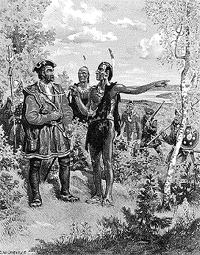
The naming of a nation
Leading up to the proposed confederation, a number of names were suggested for the northern half of the continent of North America, including: Albertsland, Albionora, Borealia, Britannia, Cabotia, Colonia, EfisgaFootnote 1, Hochelaga, Norland, Superior, Transatlantia, TuponiaFootnote 2, and Victorialand.
The debate was placed in perspective by Thomas D’Arcy McGee, who declared on February 9, 1865:
“I read in one newspaper not less than a dozen attempts to derive a new name. One individual chooses Tuponia and another Hochelaga as a suitable name for the new nationality. Now I ask any honourable member of this House how he would feel if he woke up some fine morning and found himself instead of a Canadian, a Tuponian or a Hochelagander.”
Fortunately for posterity, McGee’s wit and reasoning – along with common sense – prevailed, and on July 1, 1867, the provinces of Canada, Nova Scotia, and New Brunswick became “one Dominion under the name of Canada.”
The Dauphin Map of Canada, c. 1543, showing Cartier’s discoveries
While a variety of theories have been postulated for the name of Canada, its origin is now accepted as coming from the St. Lawrence Iroquoian word kanata, meaning ‘village’ or ‘settlement’.[1] In 1535, indigenous inhabitants of the present-day Quebec City region used the word to direct French explorer Jacques Cartier to the village of Stadacona.[2] Cartier later used the word Canada to refer not only to that particular village but to the entire area subject to Donnacona (the chief at Stadacona);[2] by 1545, European books and maps had begun referring to this small region along the Saint Lawrence River as Canada.[2]
From the 16th to the early 18th century, Canada referred to the part of New France that lay along the Saint Lawrence River.[3] In 1791, the area became two British colonies called Upper Canada and Lower Canada. These two colonies were collectively named the Canadas until their union as the British Province of Canada in 1841.[4]
Upon Confederation in 1867, Canada was adopted as the legal name for the new country at the London Conference, and the word Dominion was conferred as the country’s title.[5] By the 1950s, the term Dominion of Canada was no longer used by the United Kingdom, which considered Canada a «Realm of the Commonwealth».[6] The government of Louis St. Laurent ended the practice of using Dominion in the statutes of Canada in 1951.[7][8]
The Canada Act 1982, which brought the constitution of Canada fully under Canadian control, referred only to Canada. Later that year, the name of the national holiday was changed from Dominion Day to Canada Day.[9] The term Dominion was used to distinguish the federal government from the provinces, though after the Second World War the term federal had replaced dominion.[10]
Etymology[edit]
A map of North America from 1565, one of the first to include the name «Canada» (top right).
The name Canada is now generally accepted as originating from the St. Lawrence Iroquoian word kanata ([kana:taʔ]), meaning ‘village’ or ‘settlement’.[11][12] Related translations include ‘land’ or ‘town’, with subsequent terminologies meaning ‘cluster of dwellings’ or ‘collection of huts’.[11][13] This explanation is historically documented in Jacques Cartier’s Bref récit et succincte narration de la navigation faite en MDXXXV et MDXXXVI.[11]
Although the Laurentian language, which was spoken by the inhabitants of St. Lawrence Valley settlements such as Stadacona (modern-day Quebec City) and Hochelaga (modern-day Montreal) in the 16th century, is now extinct, it was closely related to other dialects of the Iroquoian languages, such as the Oneida and Mohawk languages. Related cognates meaning ‘town’ include nekantaa, ganataje, and iennekanandaa in the Mohawk, Onondaga, and Seneca languages respectively.[11] Prior to archeological confirmation that the St. Lawrence Iroquois were a separate people from the Mohawk, most sources specifically linked the name’s origin to the Mohawk word instead of the Laurentian one.[14]
A 1934 three-cent stamp commemorated the four-hundredth anniversary of the discovery of Canada by the French navigator, Jacques Cartier.
A widespread perception in Canadian folklore is that Cartier misunderstood the term «Canada» as the existing proper name of the Iroquois people’s entire territory rather than the generic class noun for a town or village. For instance, the Historica Canada’s Heritage Minute episode devoted to Cartier’s landing at Hochelaga is scripted as having Cartier believe that «Kanata» or «Canada» was the established name of the entire country.[15] This is not supported by Cartier’s own writings, however—in Bref récit, Cartier fully understands the actual meaning of the word («They call a town Canada»),[16] and his earliest name for the wider territory is «le pays des Canadas» (‘country of Canadas’,[17] ‘land of Canadas’, or ‘land of villages’).
While the Saint-Lawrence Iroquoian origin for the name Canada is now widely accepted, other theories have been put forth in the past.
Iberian origin theory[edit]
The most common alternative theory suggested that the name originated when Portuguese or Spanish explorers, having explored the northern part of the continent and unable to find gold and silver, wrote cá nada (‘nothing here’ in Portuguese), acá nada, aqui nada or el cabo de nada (‘Cape Nothing’ in Spanish) on that part of their maps.[18] An alternative explanation favoured by philologist Marshall Elliott linked the name to the Spanish word cañada, meaning ‘glen’ or ‘valley’.[19][20]
The earliest iterations of the Spanish «nothing here» theory stated that the explorers made the declaration upon visiting the Bay of Chaleur,[21] while later versions left out any identifying geographic detail.
The known Portuguese presence in modern Canadian territory, meanwhile, was located in Newfoundland and Labrador. Neither region is located anywhere near Iroquoian territory, and the name Canada does not appear on any Spanish or Portuguese maps of the North American coast that predate Cartier’s visit.[20] No name for the Bay of Chaleur is attested at all in Spanish sources from that period, while the only name for Newfoundland attested in Portuguese sources is Terra Nova do Bacalhau, after the region’s plentiful cod.
In most versions of the Iberian origin theory, the Spanish or Portuguese passed their name on to the Iroquois, who rapidly adopted it in place of their own prior word for a village;[20] however, no historical evidence for any such Iberian-Iroquoian interaction has ever actually been found.[20] Elliott’s «valley» theory, conversely, was that the Spanish gave their name for the area directly to Jacques Cartier, who then entirely ignored or passed over the virtually identical Iroquoian word.[20] According to Elliott, Cartier never explicitly stated that there was a direct connection between canada or kanata as the Iroquoian word for ‘village’ and Canada as the new name of the entire territory, and never accounted for the spelling difference between kanata and Canada—and thus the Spanish etymology had to be favoured because the spellings matched.[20] Notably, Cartier never wrote of having any awareness of any preexisting Spanish or Portuguese name for the region either, meaning that Elliott’s allegation that the kanata derivation was not adequately supported by Cartier’s own writing on the matter was also true of his own preferred theory.
Franciscan priest André Thevet claimed that the word derived from segnada Canada, an answer reportedly given by Spaniards in the St. Lawrence Valley area when asked what their purpose was; according to Thevet, the phrase meant that they were seeking land[22] or that they were hunting.[23] These words do not actually exist in Spanish, however.
Minor or humorous theories[edit]
British philologist B. Davies surmised that by the same process which initially saw the First Nations mislabelled as Indians, the country came to be named for the Carnata region of India or that region’s Kannada ethnic group;[24] however, this theory has attracted no significant support from other academics.[11]
Additional theories have attributed the name «Canada» to: a word in an unspecified indigenous language for ‘mouth of the country’ in reference to the Gulf of St. Lawrence;[11] a Cree word for ‘neat or clean’;[25] a claimed Innu war cry of «kan-na-dun, Kunatun«;[23] a shared Cree and Innu word, p’konata, which purportedly meant ‘without a plan’ or ‘I don’t know’;[26] a short-lived French colony purportedly established by a settler whose surname was Cane;[11] Jacques Cartier’s description elsewhere in his writings of Labrador as «the land God gave to Cain;» or, to a claim that the early French habitants demanded a «can a day» of spruce beer from the local intendant[11] (a claim easily debunked by the facts that the habitants would have been speaking French, not English, and that canning did not exist until the 19th century).
In their 1983 book The Anglo Guide to Survival in Québec, humourists Josh Freed and Jon Kalina tied the Iberian origin theory to the phrase nada mas caca (‘nothing but shit’).[27] No historian or linguist has ever analyzed this explanation as anything more than an obvious joke.
Canadian[edit]
The demonym «Canadien» or «Canadian» once referred exclusively to the indigenous groups who were native to the territory.[20] Its use was extended over time to the French settlers of New France, and later the English settlers of Upper Canada.[20]
Colonial usage[edit]
New France[edit]
European explorer Jacques Cartier transcribed the Saint-Lawrence Iroquoian word (pronounced [kanata]) as «Canada» and was the first European to use the word to refer not only to the village of Stadacona but also to the neighbouring region and to the Saint Lawrence River, which he called rivière de Canada during his second voyage in 1535.[28][29] By the mid 1500s, European books and maps began referring to this region as Canada.[30]
Canada soon after became the name of a colony in New France that stretched along the St. Lawrence River.[30][31] The terms «Canada» and «New France» were often used interchangeably during the colonial period.[30]
British North America[edit]
After the British conquest of New France (including ceding of the French colony, Canada) in 1763, the colony was renamed the Province of Quebec. Following the American Revolution and the influx of United Empire Loyalists into Quebec, the colony was split on 26 December 1791 into Upper and Lower Canada, sometime being collectively known as «The Canadas», the first time that the name «Canada» was used officially in the British regime.[32]
Some reports from the 1840s suggest that in that era, the word «Canada» was commonly pronounced «Kaugh-na-daugh» rather than its more contemporary pronunciation.[20]
Upper and Lower Canada were merged into one colony, the Province of Canada, in 1841, based on the recommendations of the Durham Report.[11] The former colonies were then known as Canada East and Canada West, and a single legislature was established with equal representation from each. Underpopulated Canada West opposed demands by Canada East for representation by population, but the roles reversed as Canada West’s population surpassed the east’s. The single colony remained governed in this way until 1 July 1867, often with coalition governments. A new capital city was being built at Ottawa, chosen in 1857 by Queen Victoria, and became a national capital.
Selection of the name Canada[edit]
Proclamation announcing the formation of one Dominion, under the name of CANADA, 1867
At the conferences held in London to determine the form of confederation that would unite the Province of Canada (now Ontario and Quebec), the Province of New Brunswick, and the Province of Nova Scotia, a delegate from either Nova Scotia or New Brunswick proposed the name Canada in February 1867, and it was unanimously accepted by the other delegates. There appears to have been little discussion,[33] though other names were suggested.
Other proposed names[edit]
While the provinces’ delegates spent little time, if any, in settling on Canada as the name for the new country, others proposed a variety of other names:[34][11]
- Anglia – the medieval Latin name for England
- Albionoria – ‘Albion of the north’
- Borealia – from borealis, the Latin word for ‘northern’; compare with Australia
- Cabotia – in honour of Italian explorer John Cabot, who explored the eastern coast of Canada for England
- Colonia
- Efisga – an acronym of English, French, Irish, Scottish, German, Aboriginal
- Hochelaga – an old name for Montreal
- Laurentia
- Mesopelagia – ‘land between the seas’
- New Albion
- Norland
- Superior
- Tupona – acronym for The United Provinces of North America
- Transatlantica
- Ursalia – ‘place of bears’
- Vesperia – ‘land of the evening star’
- Victorialand – in honour of Queen Victoria
Walter Bagehot of The Economist newspaper in London argued that the new nation should be called Northland or Anglia instead of Canada.[35] On these names, the statesman Thomas D’Arcy McGee commented, «Now I would ask any honourable member of the House how he would feel if he woke up some fine morning and found himself, instead of a Canadian, a Tuponian or a Hochelegander?».[36]
Kingdom and Dominion[edit]
Working towards the Confederation of Canada, Canada’s founders deliberated on the official title for their new country, primarily between the «Kingdom of Canada» or the «Dominion of Canada.»[37][38]
In J. S. Ewart’s two volume work, The Kingdom Papers,[39][40] it is noted that the following names were considered for the union of British North America: «The United Colony of Canada», «the United Provinces of Canada», and «the Federated Provinces of Canada».[41] Ewart was also an ardent advocate for the formation of «the Republic of Canada», a position which was rarely expressed in those times.[42]
Kingdom of Canada[edit]
During the Charlottetown Conference of 1864, John A. Macdonald, who later became the first Prime Minister of Canada, talked of «founding a great British monarchy,» in connection with the British Empire. He advocated, in the fourth Canadian draft of the British North America Act, the name «Kingdom of Canada,»[37] in the text is said:
The word ‘Parliament’ shall mean the Legislature or Parliament of the Kingdom of Canada.
The word ‘Kingdom’ shall mean and comprehend the United Provinces of Ontario, Quebec, Nova Scotia, and New Brunswick.The words ‘Privy Council’ shall mean such persons as may from time to time be appointed, by the Governor General, and sworn to aid and advise in the Government of the Kingdom.[43]
Canada’s founders, led by Macdonald, wished their new nation to be called the Kingdom of Canada in order to «fix the monarchical basis of the constitution.»[44] The governor general at the time, The 4th Viscount Monck, supported the move to designate Canada a kingdom;[45] however, officials at the Colonial Office in London opposed this potentially «premature» and «pretentious» reference for a new country. They were also wary of antagonizing the United States, which had emerged from its Civil War as a formidable military power with unsettled grievances because British interests had sold ships to the Confederacy despite a blockade, and thus opposed the use of terms such as kingdom or empire to describe the new country.[46]
Adoption of Dominion[edit]
Map of the British Empire under Queen Victoria at the end of the nineteenth century. «Dominions» refers to all territories belonging to the Crown.
Sir Samuel Leonard Tilley, Premier of New Brunswick, suggested the term Dominion,[i] inspired by Psalm 72:8 (from the King James Bible): «He shall have dominion also from sea to sea, and from the river unto the ends of the earth.»[38] This is also echoed in Canada’s motto: A Mari Usque Ad Mare (Latin for ‘from sea to sea’).[47]
The term Dominion had been used for centuries to refer to the lands held by a monarch,[48] and had previously been adopted as titles for the Dominion of New England and the Dominion and Colony of Virginia. It continued to apply as a generic term for the major colonial possessions of the British Empire until well into the 20th century;[49] although Tilley and the other Fathers of Confederation broadened the meaning of the word dominion to a «virtual synonym for sovereign state.»[50] Its adoption as a title for Canada in 1867 served the purpose of upholding the monarchist principle in Canada; in a letter to Queen Victoria, Lord Carnarvon stated:[51]
The North American delegates are anxious that the United Provinces should be designated as the ‘Dominion of Canada.’ It is a new title, but intended on their part as a tribute to the Monarchical principle which they earnestly desire to uphold.[51]
Macdonald, however, bemoaned its adoption. In a letter to Lord Knutsford on the topic of the loss of the use of the word kingdom, Macdonald said:
Canadian post card from 1905.
A great opportunity was lost in 1867 when the Dominion was formed out of the several provinces…The declaration of all the B.N.A. provinces that they desired as one dominion to remain a portion of the Empire, showed what wise government and generous treatment would do, and should have been marked as an epoch in the history of England. This would probably have been the case had Lord Carnarvon, who, as colonial minister, had sat at the cradle of the new Dominion, remained in office. His ill-omened resignation was followed by the appointment of the late Duke of Buckingham, who had as his adviser the then Governor General, Lord Monck — both good men, certainly, but quite unable, from the constitution of their minds, to rise to the occasion. Had a different course been pursued, for instance, had united Canada been declared to be an auxiliary kingdom, as it was in the Canadian draft of the bill, I feel sure almost that the Australian colonies would, ere this, have been applying to be placed in the same rank as The Kingdom of Canada.[52][53]
He added as a postscript that it was adopted on the suggestion of British colonial ministers to avoid offending republican sensibilities in the United States:
P.S. On reading the above over I see that it will convey the impression that the change of title from Kingdom to Dominion was caused by the Duke of Buckingham. This is not so. It was made at the instance of Lord Derby, then foreign minister, who feared the first name would wound the sensibilities of the Yankees. I mentioned this incident in our history to Lord Beaconsfield at Hughenden in 1879, who said, ‘I was not aware of the circumstance, but it is so like Derby, a very good fellow, but who lives in a region of perpetual funk.’[54]
Use of the term dominion was formalized in 1867 through Canadian Confederation. In the Constitution of Canada, namely the Constitution Act, 1867 (British North America Acts), the preamble of the Act indicates:
Whereas the Provinces of Canada, Nova Scotia, and New Brunswick have expressed their Desire to be federally united into One Dominion under the Crown of the United Kingdom of Great Britain and Ireland, with a Constitution similar in Principle to that of the United Kingdom….[55]
Moreover, section 2 indicates that the provinces:
… shall form and be One Dominion under the Name of Canada; and on and after that Day those Three Provinces shall form and be One Dominion under that Name accordingly.[55]
French terms[edit]
The French translation of the 1867 British North America Act translated «One Dominion under the Name of Canada» as «une seule et même Puissance sous le nom de Canada» using Puissance (‘power’) as a translation for dominion. Later, the English loanword dominion was also used in French.[56]
The Fathers of Confederation met at the Quebec Conference of 1864 to discuss the terms of this new union. One issue on the agenda was to determine the Union’s «feudal rank» (see Resolution 71 of the Quebec Conference, 1864). The candidates for the classification of this new union were: le Royaume du Canada (‘the Kingdom or Realm of Canada’), l’Union du Canada (‘the Union of Canada’), and le Dominion du Canada (‘the Dominion of Canada’).
Use of Dominion[edit]
There are numerous references in United Kingdom Acts of Parliament to «the Dominion of Canada;» and the British North America Act, 1867 (BNA Act) referred to the formation of «one Dominion under the name of Canada.»[57] Section 4 of the BNA Act also declares that: «Unless it is otherwise expressed or implied, the Name Canada shall be taken to mean Canada as constituted under this Act;» this has been interpreted to mean that the title of the country is simply Canada. Nonetheless, the term «Dominion of Canada» appears in the Constitution Act, 1871—the usage of which was «sanctioned»[58]—and both «Canada» and «Dominion of Canada» appear in other texts of the period, as well as on numerous Canadian banknotes before 1935.
Until the 1950s, the term Dominion of Canada was commonly used to identify the country. As the country acquired political authority and autonomy from the United Kingdom, the federal government began using simply Canada on state documents. Quebec nationalist leaders also objected to dominion, arguing that it suggested Ottawa would have control over Quebec.
Under Prime Minister Louis St-Laurent, compromises were reached that quietly, and without legislation, «Dominion» would be retired in official names and statements, usually replaced by «federal». The St. Laurent government thereby ended the practice of using «Dominion» in the Statutes of Canada in 1951.[59]
The independence of the separate Commonwealth realms was emphasised after the accession of Queen Elizabeth II in 1952, when she was proclaimed not just as Queen of the United Kingdom, but also Queen of Canada, Queen of Australia, Queen of New Zealand, Queen of South Africa, and of all her other «realms and territories».[6] This also reflected the change from dominion to realm; in the proclamation of Queen Elizabeth II’s new titles in 1953, the phrase «of her other Realms and Territories» replaced «dominion» with another mediaeval French word with the same connotation, «realm» (from royaume).[60]
With that said, the national holiday of «Dominion Day» kept that name until May 1980, when a private member’s bill to replace the name with Canada Day was unexpectedly passed in the House. In the Senate, Eugene Forsey and the Monarchist League of Canada strongly defended the traditional usage. When a Gallup poll showed 70% of all Canadians favoured the change, the Senate approved the bill without a recorded vote.[61]
The Canada Act 1982 refers only to Canada and does not use the term dominion. No constitutional statute amends this name, nor does any Canadian legal document state that the name of the country is anything other than Canada.[62] Moreover, official sources of the United Nations system,[63][64]
international organizations (such as the Organization of American States),[65] the European Union,[66]
the United States,[67] and other polities with which Canada has official relations as a state either consistently use Canada as the only official name, affirm that Canada has no long-form name, or affirm that the formal name is simply Canada.
The terms Dominion and Dominion of Canada are still considered to be appropriate, although arcane, titles for the country.[68][69][70] The federal government continues to produce publications and educational materials that specify the currency of these titles, although these publications are not themselves legal or official documents.[71][72][73]
For instance, in 2008 the Canadian government registered the Maple Leaf Tartan, designed in 1964, with the Scottish Tartans Authority. The tartan’s alternate name is «Dominion of Canada.»[74][75]
The term Dominion and Dominion of Canada is also used in a colonial historical sense, having been used to distinguish contemporary (post-1867) Canada from either the earlier Province of Canada or from the even earlier The Canadas and modern history of the current realms.[76] The terms have also been used to distinguish the federal government from the provinces, though in this usage, «federal» has replaced «dominion». For example, The Canadian Almanac stopped using Dominion of Canada in 1964.[77]
See also[edit]
- List of Canadian place names of royal heritage
- Canadian provincial and territorial name etymologies
- Origins of names of cities in Canada
- List of Canadian place names of Ukrainian origin
- List of Canadian place names of Indigenous origin
- List of Canadian place names of English origin
- List of Canadian place names of Scottish origin
- List of Canadian place names of Spanish origin
Notes[edit]
- ^ «Dominion (noun).» Merriam-Webster Dictionary: «a self-governing nation of the Commonwealth of Nations other than the United Kingdom that acknowledges the British monarch as chief of state»
References[edit]
- ^ Olson, James Stuart; Shadle, Robert (1991). Historical Dictionary of European Imperialism. Greenwood Publishing Group. p. 109. ISBN 978-0-313-26257-9.
- ^ a b c Rayburn 2001, pp. 14–22.
- ^ Magocsi, Paul R. (1999). Encyclopedia of Canada’s Peoples. University of Toronto Press. p. 1048. ISBN 978-0-8020-2938-6.
- ^ «An Act to Re-write the Provinces of Upper and Lower Canada, and for the Government of Canada». J.C. Fisher & W. Kimble. 1841. p. 20.
- ^ O’Toole, Roger (2009). «Dominion of the Gods: Religious continuity and change in a Canadian context». In Hvithamar, Annika; Warburg, Margit; Jacobsen, Brian Arly (eds.). Holy Nations and Global Identities: Civil Religion, Nationalism, and Globalisation. Brill. p. 137. ISBN 978-90-04-17828-1.
- ^ a b Morra, Irene (2016). The New Elizabethan Age: Culture, Society and National Identity after World War II. I.B.Tauris. p. 49. ISBN 978-0-85772-867-8.
- ^ «November 8, 1951 (21st Parliament, 5th Session)». Canadian Hansard Dataset. Retrieved April 9, 2019.
- ^ Bowden, J.W.J. (2015). «‘Dominion’: A Lament». The Dorchester Review. 5 (2): 58–64.
- ^ Buckner, Philip, ed. (2008). Canada and the British Empire. Oxford University Press. pp. 37–40, 56–59, 114, 124–125. ISBN 978-0-19-927164-1.
- ^ Courtney, John; Smith, David (2010). The Oxford Handbook of Canadian Politics. Oxford University Press. p. 114. ISBN 978-0-19-533535-4.
- ^ a b c d e f g h i j Rayburn 2001, pp. 14–17.
- ^ Mithun 1999, p. 312.
- ^ Hawkins, Alfred; John Charlton Fisher (1834). «7». Hawkins’s Picture of Quebec: With Historical Recollections. Printed for the proprietor by Neilson and Cowan. p. 111.
in the note of Charlevoix, Nouvelle France, volume the first, page nine, of the quarto edition, and repeated in «Beautés de l’Histoire du Canada» affords the real solution of the difficulty: «Quelqu’uns derivent ce nom du mot Iroquois Kannata qui se prononce Cannada, et signifie un amas de cabanes;»–»Some derive this name from the Iroquois word Kannata, pronounced Cannada, signifying a collection of huts.»
- ^ Johansen 1999, p. 49.
- ^ «Heritage Minutes: Jacques Cartier» Archived 2013-10-04 at the Wayback Machine. Historica Foundation of Canada.
- ^ Francis, Jones & Smith 2009, p. 27.
- ^ Cook, Ramsay (2017). The Voyages of Jacques Cartier. University of Toronto Press. ISBN 9781442658042. Archived from the original on February 2, 2017.
- ^ John George Hodgins (1858). The Geography and History of British America, and of the Other Colonies of the Empire: To which are Added a Sketch of the Various Indian Tribes of Canada, and Brief Biographical Notices of Eminent Persons Connected with the History of Canada. Maclear & Company. p. 51.
- ^ «Further Conjectures as to the Origin of the Name ‘Canada'». The New York Times, September 5, 1908.
- ^ a b c d e f g h i Orkin 2010, pp. 38–43.
- ^ Jefferys, Thomas. 1754. The Conduct of the French, with Regard to Nova Scotia. London: T. Jefferys.
- ^ Gervais Carpin, Histoire d’un mot: l’ethnonyme «canadien» de 1535-1691. Les Éditions de Septentrion, 1995. ISBN 9782894480366. p. 50.
- ^ a b Olive Dickason, Le mythe du sauvage. Les Éditions de Septentrion, 1993. ISBN 9782921114967. p. 298.
- ^ Canadian Naturalist and Geologist, December 1861. p. 432.
- ^ John Maclean, Canadian Savage Folk: The Native Tribes of Canada. C. W. Coates, 1986.
- ^ Joseph Graham, Naming the Laurentians: A History of Place Names ‘up North’. Les Éditions Main Street, 2005. ISBN 9780973958607. p. 65
- ^ Josh Freed and Jon Kalina, The Anglo Guide to Survival in Québec. Eden Press, 1983. ISBN 978-0920792339. p. 89.
- ^ Marsh 1999, p. 355.
- ^ Roger E. Riendeau (2007). A Brief History of Canada. Infobase Publishing. p. 27. ISBN 978-1-4381-0822-3. Archived from the original on February 17, 2017.
- ^ a b c Warkentin & Podruchny 2001, p. 234.
- ^ MCC. «Le territoire Archived 2008-09-20 at the Wayback Machine», in La Nouvelle-France. Ressources françaises, Ministère de la Culture et de la Communication (France), 1998, retrieved 2 August 2008
- ^ «Canadian Heritage — Origin of the Name — Canada». Pch.gc.ca. April 27, 2011. Archived from the original on October 12, 2011. Retrieved October 26, 2011.
- ^ Creighton, Donald. 1956. The Road to Confederation. Houghton Mifflin: Boston; p. 421.
- ^ «How Canada Got Its Name — Origin of the Name Canada». Canadaonline.about.com. Archived from the original on December 7, 2010. Retrieved June 11, 2010.
- ^ Moore, Christopher. 1997. 1867: How the Fathers Made a Deal. McClelland and Stewart: Toronto; p. 214.
- ^ John Robert Colombo (June 1, 2001). 1000 Questions About Canada: Places, People, Things, and Ideas : A Question-And-Answer Book on Canadian Facts and Culture. Dundurn Press Ltd. p. 335. ISBN 978-0-88882-232-1. Archived from the original on March 19, 2015.
- ^ a b Farthing, John; Freedom Wears a Crown; Toronto, 1957
- ^ a b «Sir Samuel Leonard Tilley» Archived 2007-10-01 at the Wayback Machine Library and Archives Canada.
- ^ Ewart 1912–1917, p. 331
- ^ Ewart 1912–1917, p. 393
- ^ Ewart 1912–1917, pp. 372–393; as per «Rank and Name», pp. 374–381.
- ^ Ewart 1912–1917, Imperial Projects and the Republic of Canada, pp. 262–393.
- ^ Pope, Joseph; Confederation; pg. 177
- ^ George M. Wrong; H. H. Langton (2009). The Chronicles of Canada: Volume VIII — The Growth of Nationality. Fireship Press. p. 60. ISBN 978-1-934757-51-2. Archived from the original on June 29, 2014. Retrieved July 1, 2010.
- ^ Hubbard, R.H.; Rideau Hall; McGill-Queen’s University Press; Montreal and London; 1977; p. 9
- ^ R. Douglas Francis; Richard Jones; Donald B. Smith (2009). Journeys: A History of Canada. Cengage Learning. p. 246. ISBN 978-0-17-644244-6. Archived from the original on March 19, 2015.
- ^ Reingard M. Nischik (2008). History of Literature in Canada: English-Canadian and French-Canadian. Camden House. p. 113. ISBN 978-1-57113-359-5. Archived from the original on March 19, 2015.
- ^ Treaty of Utrecht 1713 «Moreover, the most Christian King promises, as well in his own name, as in that of his heirs and successors, that they will at not time whatever disturb or give any molestation to the Queen of Great Britain, her heirs and successors, descended from the aforesaid Protestant line, who possess the crown of Great Britain, and the dominions belonging therunto.»
- ^ «… on the 23rd of April 1895, Tongaland was declared by proclamation to be added to the dominions of Queen Victoria … » («Africa» . Encyclopædia Britannica. Vol. 1 (11th ed.). 1911. p. 343.)
- ^ Delisle, Jean (October 8, 2009). «Through the Lens of History: Translating dominion as puissance». Government of Canada. Archived from the original on December 24, 2013. Retrieved June 24, 2013.
- ^ a b «The Prince of Wales Royal Visit 2001, Quiz (Kids)». Canadian Heritage. January 9, 2009. Archived from the original on June 16, 2008. Retrieved June 11, 2010.
- ^ Arthur Bousfield; Garry Toffoli (1991). Royal Observations: Canadians & Royalty. Dundurn Press Ltd. p. 152. ISBN 978-1-55002-076-2.
- ^ Joseph Pope (1894). Memoirs of the Right Honourable Sir John Alexander Macdonald, G. C. B., first Prime Minister of the Dominion of Canada. E. Arnold. p. 321.
- ^ «Senator Cools congratulates Her Majesty Queen Elizabeth II on her Forty-Seventh Anniversary of Accession to Throne, Feb 11, 1999». Senatorcools.sencanada.ca. Archived from the original on April 25, 2012. Retrieved October 26, 2011.
- ^ a b Dennis Ambrose O’Sullivan (1887). Government in Canada: The principles and institutions of our federal and provincial constitutions. The B. N. A. act, 1867, compared with the United States Constitution, with a sketch of the constitutional history of Canada. Carswell & co. p. 309.
- ^ Le Petit Robert 1: dictionnaire de la langue française, 1990.
- ^ Commonwealth and Colonial Law by Kenneth Roberts-Wray, London, Stevens, 1966. P. 17 (direct quote, word for word)
- ^ Martin, Robert. 1993. Eugene Forsey Memorial Lecture: A Lament for British North America. Archived 2005-10-17 at the Wayback Machine The Machray Review. Prayer Book Society of Canada.—A summative piece about nomenclature and pertinent history with abundant references.
- ^ «November 8, 1951 (21st Parliament, 5th Session)». Retrieved April 9, 2019.
- ^ King, Robert D.; Kilson, Robin W. (September 7, 1999). The Statecraft of British Imperialism: Essays in Honour of Wm. Roger Louis. Taylor & Francis. ISBN 9780714643786 – via Google Books.
- ^ Alan Rayburn, Naming Canada: Stories about Canadian Place Names (2001) pp 17–22.
- ^ «Government of Canada Translation Bureau, «List of Country Names»—Introduction notes that «The official name of a state (e.g. Islamic Republic of Iran), found under the common name (Iran), is taken from the United Nations Terminology Bulletin No. 347.»«. Btb.gc.ca. March 18, 2009. Archived from the original on January 17, 2010. Retrieved June 11, 2010.
- ^ «The UN Terminology website «which holds records for each country containing the short and formal names in the six UN official languages, is the successor to UN Terminology». United Nations Multilingual Terminology Database (UNTERM.UN.ORG), Canada page. Archived from the original on May 8, 2014.
- ^
«UNITED NATIONS GROUP OF EXPERTS ON GEOGRAPHICAL NAMES, Working Paper No. 16» (PDF). p. Bulletin No. 347/Rev. 1. Archived from the original (PDF) on February 27, 2008. - ^ «Organization of American States Office of Legal Cooperation, Member Country Information Page for Canada». Oas.org. Archived from the original on June 27, 2010. Retrieved June 11, 2010.
- ^ «European Union Gateway Interinstutional Style Guide, List of Countries, territories and currencies — «Note 1, ‘Full name’ corresponds in most cases to the official name recognized by the United Nations.»«. Publications.europa.eu. Archived from the original on August 5, 2013. Retrieved June 11, 2010.
- ^ «United States Department of State Bureau of Intelligence and Research, Independent States of the World—Canada: «no long-form name»«. State.gov. January 1, 1979. Retrieved June 11, 2010.
- ^ Forsey, Eugene A., in Marsh, James H., ed. 1988. «DominionArchived 2017-01-22 at the Wayback Machine» The Canadian Encyclopedia. Hurtig Publishers: Toronto.
- ^ Rayburn 2001, pp. 19, 21.
- ^ Canadian Heritage: National Flag of Canada Day — How Did You Do? Archived 2011-06-11 at the Wayback Machine, Canada’s Digital Collections: Confederation 1867, Canadian Heritage: The Prince of Wales Royal Visit 2001, Quiz.
- ^ Canadian Heritage: National Flag of Canada Day — How Did You Do? Archived 2011-06-11 at the Wayback Machine, Canada’s Digital Collections: Confederation 1867, Canadian Heritage: The Prince of Wales Royal Visit 2001, Quiz
- ^
Forsey, Eugene A. 2005. How Canadians Govern Themselves Archived 2009-03-25 at the Wayback Machine (PDF), 6th ed. Canada: Ottawa; pp. 8-9. The preface to the publication specifies that the opinions reflected are those of the author, and «do not necessarily reflect those of parliament.» - ^
«Territorial evolution». Atlas of Canada. Natural Resources Canada. Archived from the original on April 13, 2010. Retrieved October 9, 2007.In 1867, the colonies of Canada, Nova Scotia and New Brunswick are united in a federal state, the Dominion of Canada.
- ^ «Tartan Display». Scottish Tartan Authority. Retrieved April 10, 2019.
- ^ BRIAN LILLEY, Parliamentary Bureau (March 9, 2011). «It’s official, Maple Leaf Tartan is Canada’s tartan | Canada | News». Toronto Sun. Retrieved October 26, 2011.
- ^ «Dominion of Canada | The Canadian Encyclopedia». www.thecanadianencyclopedia.ca.
- ^ «Dominion of Canada FAQ». jjmccullough.com. Retrieved April 9, 2019.
Bibliography[edit]
- Ewart, J.S. (1912–1917). The Kingdom Papers. Vol. I. Toronto: McClelland, Goodchild, and Stewart. Archived from the original on February 15, 2006.
- Francis, R. Douglas; Jones, Richard; Smith, Donald B. (2009). Journeys: A History of Canada. Nelson College. ISBN 978-0176442446.
- Johansen, Bruce Elliott (1999). The Encyclopedia of Native American Economic History. Greenwood Publishing Group. ISBN 978-0313306235.
- Marsh, James H. (1999). The Canadian Encyclopedia. The Canadian Encyclopedia. ISBN 978-0-7710-2099-5. Archived from the original on March 25, 2017.
- Mithun, Marianne (1999). The Languages of Native North America. Cambridge: Cambridge University Press. ISBN 0-521-29875-X.
- Orkin, Mark M (2010), «The Name Canada: An Etymological Enigma» (PDF), Canadian English: A Linguistic Reader, Kingston, Ontario: Strathy Language Unit, Queen’s University, archived from the original (PDF) on September 24, 2015
- Rayburn, Alan (2001). Naming Canada: Stories about Canadian Place Names. University of Toronto Press. pp. 14–17. ISBN 978-0-8020-8293-0. Archived from the original on April 12, 2016.
- Warkentin, Germaine; Podruchny, Carolyn (2001). Decentring the Renaissance: Canada and Europe in Multidisciplinary Perspective, 1500-1700. University of Toronto Press. ISBN 978-0-8020-8149-0. Archived from the original on June 10, 2016.
Further reading[edit]
- Choudry, Sujit. 2001(?). «Constitution Acts» (based on looseleaf by Hogg, Peter W.). Constitutional Keywords. University of Alberta, Centre for Constitutional Studies: Edmonton.
- Gerald Hallowell (2004). The Oxford Companion to Canadian History. Oxford University Press Canada. ISBN 978-0-19-541559-9.
External links[edit]
- Dominion of Canada FAQ
- Origin of the Name — Canada — Canadian Heritage






